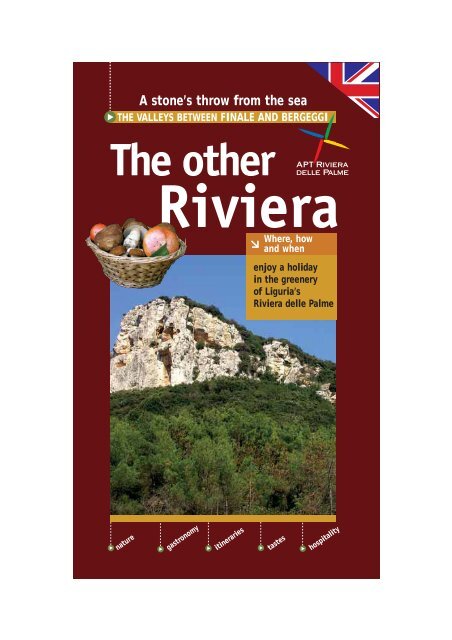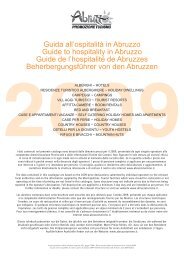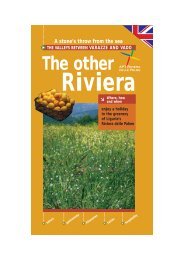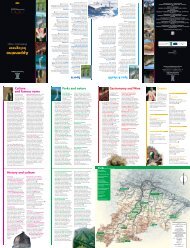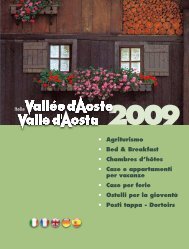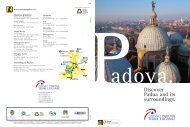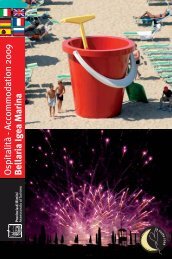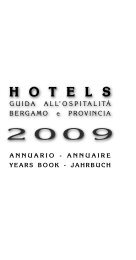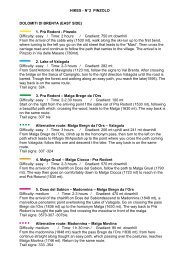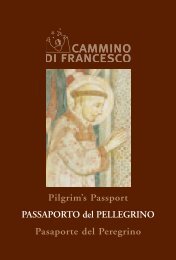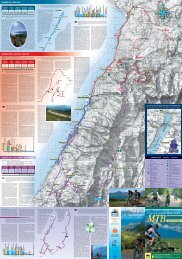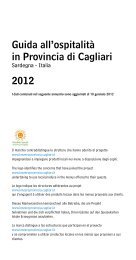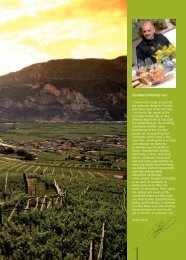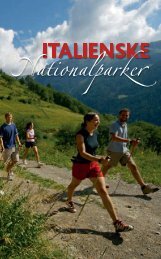A stone's throw from the sea
A stone's throw from the sea
A stone's throw from the sea
Create successful ePaper yourself
Turn your PDF publications into a flip-book with our unique Google optimized e-Paper software.
A stone’s <strong>throw</strong> <strong>from</strong> <strong>the</strong> <strong>sea</strong><br />
THE VALLEYS BETWEEN FINALE AND BERGEGGI<br />
Where, how<br />
and when<br />
enjoy a holiday<br />
in <strong>the</strong> greenery<br />
of Liguria’s<br />
Riviera delle Palme<br />
nature<br />
gastronomy<br />
itineraries<br />
tastes<br />
hospitality
<strong>the</strong> o<strong>the</strong>r riviera<br />
The valleys between<br />
Finale and Bergeggi<br />
The stretch of <strong>the</strong> Riviera delle Palme between Finale Ligure and Bergeggi<br />
is undoubtedly one of <strong>the</strong> most beautiful on <strong>the</strong> whole Ligurian Riviera,<br />
but its hinterland is – if possible – even more evocative. This is <strong>the</strong> O<strong>the</strong>r<br />
Riviera, unique and unexpected. It combines all <strong>the</strong> best of <strong>the</strong> region’s<br />
natural and historical heritage for <strong>the</strong> joy of visitors. Just a few bends and<br />
a several kilometres along <strong>the</strong> road behind Finale and Noli will take you<br />
to <strong>the</strong> Manie Plateau. This wild land was created by <strong>the</strong> geological whims<br />
of <strong>the</strong> earth and has been preserved intact by <strong>the</strong> wisdom of those who<br />
have lived here: <strong>the</strong> prehistoric Ligurians who inhabited its caves; <strong>the</strong><br />
Romans who crossed it with <strong>the</strong>ir roads and stone bridges; and finally <strong>the</strong><br />
generations of peasants who have used it to produce excellent olive oil<br />
and fine wine – and all with <strong>the</strong> deep blue <strong>sea</strong> right below. Fur<strong>the</strong>r inland,<br />
down towards <strong>the</strong> Po Valley, are <strong>the</strong> Bormida Valleys, with <strong>the</strong>ir huge,<br />
protected forests, feudal castles, wild mushrooms and truffles, colourful<br />
villages, and more besides…
Pora Valley<br />
Bormida di Pàllare Valley<br />
Bormida di Màllare Valley<br />
The Manie Plateau<br />
Bormida di Millesimo Valley<br />
FINALE LIGURE<br />
Noli Spotorno Bergeggi Vado<br />
3
<strong>the</strong> o<strong>the</strong>r riviera<br />
The Manie Plateau<br />
and <strong>the</strong> Pora Valley<br />
NOLI<br />
Voze and Tosse<br />
A limestone <strong>sea</strong><br />
In prehistoric times this area was a warm, tropical <strong>sea</strong>.<br />
The <strong>sea</strong> bed formed gradually as <strong>the</strong> shells and skeletons<br />
of thousands and thousand of calcareous organisms were<br />
deposited. The skeletons and shells eventually became<br />
rock: Finale stone, a pale limestone that was raised high<br />
above <strong>sea</strong> level during <strong>the</strong> formation of <strong>the</strong> Alps.<br />
The ancient <strong>sea</strong>floor now forms <strong>the</strong> hills, plateau, caves<br />
and rocky cliffs that make <strong>the</strong> Finale Ligure area so<br />
picturesque and famous. The Manie Plateau and <strong>the</strong><br />
Pora Valley remain a well-preserved and untamed region,<br />
despite being so close to <strong>the</strong> coast. The air here is<br />
perfumed by <strong>the</strong> maquis and <strong>the</strong> green landscape is<br />
dotted with old faming villages surrounded by vineyards<br />
and olive groves. The sheer pale limestone rock faces<br />
attract climbers <strong>from</strong> all over <strong>the</strong> world and <strong>the</strong> mild<br />
climate allows <strong>the</strong>m to engage in <strong>the</strong>ir sport all year<br />
round, whilst <strong>the</strong> forests and rocks conceal caves bearing<br />
traces of prehistoric Liguria. It is no exaggeration to<br />
say that this is an absolutely unique corner of <strong>the</strong><br />
world, for <strong>the</strong> Mediterranean coast has<br />
no o<strong>the</strong>r spot that can compare with <strong>the</strong><br />
Manie Plateau.<br />
THE HILLS OF NOLI<br />
Voze and Tosse<br />
4<br />
The two hamlets of Tosse and Voze<br />
are immersed in <strong>the</strong> maquis that<br />
covers <strong>the</strong> hills behind Noli, surrounded by<br />
olive groves. The air here is perfumed with<br />
<strong>the</strong> scent of broom and <strong>the</strong> strips of land<br />
are planted with rows of vines.<br />
In Roman times <strong>the</strong><br />
Via Julia Augusta<br />
passed this way<br />
and its traces can<br />
still be seen in<br />
<strong>the</strong> woods and<br />
between <strong>the</strong><br />
houses.
sse<br />
Vezzi Portio<br />
Orco Feglino<br />
Calvisio<br />
Perti<br />
Gorra and Olle<br />
Calice Ligure<br />
Rialto<br />
FINALE<br />
LIGURE<br />
A stone’s <strong>throw</strong><br />
<strong>from</strong> <strong>the</strong> <strong>sea</strong><br />
Hail Caesar,<br />
<strong>the</strong> inns greet you!<br />
Julius Caesar probably never visited Voze, but he would<br />
have found good reasons for stopping here if he had.<br />
He could have chosen <strong>from</strong> <strong>the</strong> Albergo Ristorante<br />
El Sito (hotel and restaurant) or <strong>the</strong> Ristorante Lilliput<br />
along <strong>the</strong> road leading down to Noli <strong>from</strong> Voze;<br />
<strong>the</strong> Locanda di Giuda (inn) offering Ligurian<br />
specialities or <strong>the</strong> Trattoria da Teresa with<br />
rooms amidst <strong>the</strong> old houses of <strong>the</strong> village;<br />
or <strong>the</strong> Ristorante Belvedere on <strong>the</strong> Roman<br />
road. The Ristorante Passu du Ventu,<br />
on <strong>the</strong> o<strong>the</strong>r hand, is located in a<br />
panoramic position at <strong>the</strong> beginning of<br />
<strong>the</strong> road to Vezzi. Good lunches are to<br />
be had at <strong>the</strong> Ristorante Mea Culpa<br />
(although it’s not clear what it has to<br />
apologise for!).<br />
Voze and Tosse: 210 metres<br />
above <strong>sea</strong> level, 4 km <strong>from</strong> <strong>the</strong><br />
A10 motorway exit (Spotorno)<br />
3 km <strong>from</strong> <strong>the</strong> <strong>sea</strong> (Noli)<br />
Vezzi Portio: 220 metres above<br />
<strong>sea</strong> level, 3 km <strong>from</strong> <strong>the</strong> A10<br />
motorway exit (Spotorno)<br />
6 km <strong>from</strong> <strong>the</strong> <strong>sea</strong> (Noli)<br />
Orco Feglino: 200 metres above<br />
<strong>sea</strong> level, 1 km <strong>from</strong> <strong>the</strong> A10<br />
motorway exit (Feglino)<br />
7 km <strong>from</strong> <strong>the</strong> <strong>sea</strong> (Finale Ligure)<br />
Calvisio: 130 metres above <strong>sea</strong><br />
level, 3 km <strong>from</strong> <strong>the</strong> A10<br />
motorway exit (Feglino)<br />
3 km <strong>from</strong> <strong>the</strong> <strong>sea</strong> (Finale Ligure)<br />
Perti: 145 metres above <strong>sea</strong> level,<br />
3 km <strong>from</strong> <strong>the</strong> A10 motorway exit<br />
(Finale Ligure), 4 km <strong>from</strong><br />
<strong>the</strong> <strong>sea</strong> (Finale Ligure)<br />
Gorra and Olle: 210 metres above<br />
<strong>sea</strong> level, 1 km <strong>from</strong> <strong>the</strong> A10<br />
motorway exit (Finale Ligure)<br />
4 km <strong>from</strong> <strong>the</strong> <strong>sea</strong> (Finale Ligure)<br />
Calice Ligure: 70 metres above<br />
<strong>sea</strong> level, 4 km <strong>from</strong> <strong>the</strong> A10<br />
motorway exit (Finale Ligure)<br />
6 km <strong>from</strong> <strong>the</strong> <strong>sea</strong> (Finale Ligure)<br />
Rialto: 370 metres above <strong>sea</strong><br />
level, 7 km <strong>from</strong> <strong>the</strong> A10<br />
motorway exit (Finale Ligure)<br />
9 km <strong>from</strong> <strong>the</strong> <strong>sea</strong> (Finale Ligure)<br />
5
<strong>the</strong> o<strong>the</strong>r riviera<br />
Vezzi Portio<br />
The hills of Noli<br />
Where, how and when<br />
Albergo Ristorante El Sito<br />
via la Malfa 2, Voze, tel. 019 748 107<br />
La locanda di Giuda<br />
strada Romana 1, Voze<br />
tel. 019 748 625<br />
Ristorante Lilliput<br />
regione Zuglieno 49, Voze<br />
tel. 019 748 009<br />
Ristorante Mea Culpa<br />
via Guardia 9, Tosse, tel. 019 745 191<br />
Ristorante Pizzeria Belvedere<br />
strada Romana 2, tel. 019 748 902<br />
Ristorante Passu du Ventu<br />
strada Romana 10, Voze<br />
telephone Circolo Ricreativo Vozese<br />
tel. 349 295 8049, 347 220 6878<br />
Trattoria da Teresa (with rooms)<br />
strada Romana 25, Voze, tel. 019 748 065<br />
VEZZI PORTIO<br />
Vineyards, olive groves<br />
and wooded strips of land<br />
Six hundred inhabitants scattered amongst small<br />
villages, clinging to strips of land covered with<br />
olive groves, vineyards and maquis. This is Vezzi<br />
Portio, in <strong>the</strong> wild inland area of Finale Liguria.<br />
It is made up of four villages, San Giorgio,<br />
San Filippo, Portio and Magnone, where <strong>the</strong> town<br />
hall is located. The hamlets offer views ranging<br />
<strong>from</strong> <strong>the</strong> bell tower of <strong>the</strong> neighbouring village<br />
to <strong>the</strong> rocky cliffs much beloved by climbers.<br />
History left has many traces here, including <strong>the</strong><br />
Porta di Spagna (Spanish Gate), a border station<br />
on <strong>the</strong> edge of <strong>the</strong> Marquisate of Finale Ligure,<br />
which belonged to <strong>the</strong> Spanish crown in <strong>the</strong><br />
seventeenth century.<br />
A couple of tasty addresses<br />
6<br />
The pretty, family-run Osteria dei Funghi (inn),<br />
on <strong>the</strong> road between Magnone and Portio is well<br />
worth a stop for a bite, whilst Giuseppa<br />
Piscitello produces excellent honey amongst<br />
<strong>the</strong> farms of Magnone, which she sells in <strong>the</strong><br />
local shops with <strong>the</strong> “Pollupice” label.
Orco Feglino<br />
The Manie Plateau and <strong>the</strong> Pora Valley<br />
Wines with a view<br />
The salty <strong>sea</strong> air mixes with forest<br />
scents and lends aroma and<br />
flavour to <strong>the</strong> gourmet delicacies<br />
of Vezzi Portio: Lumassina and<br />
Barbarossa wines, olive oil and<br />
chestnuts.<br />
Vezzi Portio<br />
Where, how and when<br />
Town Hall tel. 019 742 8000<br />
www.inforiviera.it/blu/vezzi.cfm<br />
Azienda Agricola<br />
di Giuseppa Piscitello (honey)<br />
via Magnone 10<br />
tel. 019 742 275<br />
Osteria dei Funghi<br />
via Portio 69, tel. 019 742 028<br />
ORCO FEGLINO<br />
A bunch of grapes, a pine tree and a tower…<br />
…all feature in <strong>the</strong> coat of arms of Orco Feglino, a municipality in <strong>the</strong> Finale Ligure area.<br />
It is made up of several hamlets in <strong>the</strong> upper valley of <strong>the</strong> River Aquila, with fine views<br />
over <strong>the</strong> lonely, unspoilt Cornei Valley. Terraced roofs, a common Mediterranean feature<br />
around Finale Ligure, are common here too. Feglino is situated next to <strong>the</strong> motorway, with<br />
its imposing Church of San Lorenzo and red-roofed houses. Above <strong>the</strong> motorway is <strong>the</strong><br />
white church of Santa Maria Ausiliatrice, with <strong>the</strong> nearby Cappella dell’Apparizione (Chapel<br />
of <strong>the</strong> Apparition), whilst <strong>the</strong> hill that dominates Orco is <strong>the</strong> site of <strong>the</strong> ruins of <strong>the</strong> ancient<br />
castrum Orchae and a tenth-century tower. Not far away is <strong>the</strong> Romanesque-Gothic<br />
country Church of San Lorenzino with fifteenth-century frescoes. Boragni is a<br />
country village enclosed by tall fortifications and crossed by a covered<br />
vaulted street. At Christmas <strong>the</strong> charming old town of Feglino<br />
is enlivened by <strong>the</strong> living nativity scene<br />
staged by its inhabitants.<br />
7
<strong>the</strong> o<strong>the</strong>r riviera<br />
Orco Feglino<br />
Wine, oil and peaches<br />
The area of Orco Feglino produces Lumassina and Barbarossa<br />
wines, olive oil and peaches. The trattorias serve ovoli<br />
mushrooms on vine leaves and peaches in Lumassina wine.<br />
8<br />
Rocky<br />
paths<br />
The wild,<br />
unspoilt Aquila<br />
Valley is<br />
crisscrossed with<br />
evocative paths<br />
and its rock faces<br />
are a magnet for<br />
free climbers<br />
<strong>from</strong> all over <strong>the</strong><br />
world. The Monte<br />
Cucco practice<br />
wall is very<br />
famous.<br />
Useful addresses<br />
You can eat and sleep like a lord<br />
around Orco and Feglino! Feglino<br />
is home to <strong>the</strong> Locanda Ristorante<br />
Borgo Antico (inn and restaurant)<br />
and <strong>the</strong> Locanda Ristorante Del<br />
Rio (inn and restaurant), as well<br />
as Giovanni Bonora’s rooming<br />
house, <strong>the</strong> Ristorante da Anna<br />
and <strong>the</strong> Ristorante il Portico.<br />
The central part of <strong>the</strong> valley floor<br />
also boasts <strong>the</strong> Agriturismo<br />
Aspettando il Sole (guest farm),<br />
offering food and accommodation,<br />
horse riding, garden and poultry<br />
produce, and <strong>the</strong> Agriturismo<br />
Da Beppe e Lucia (guest farm),<br />
with its soft beds, tasty meals,<br />
oil and wine.<br />
The roads that climb up to Orco<br />
lead to <strong>the</strong> Ristorante con camere<br />
La Sosta (restaurant with rooms)<br />
in Bonomi, and <strong>the</strong> Ristorante<br />
Pizzeria il Rifugio at <strong>the</strong> Monte<br />
Cucco practice wall. Visitors to Orco<br />
can stay at <strong>the</strong> B&B di Nicoletta<br />
Pozzi and <strong>the</strong> B&B Cà Bassi,<br />
towards Boragni, next to <strong>the</strong><br />
Azienda Agrituristica Cà Magli<br />
(guest farm).
The Manie Plateau and <strong>the</strong> Pora Valley<br />
Orco Feglino<br />
Where, how and when<br />
Town Hall tel. 019 699 010<br />
www.inforiviera.it/blu/orco.cfm<br />
Affittacamere Giovanni Bonora<br />
via Aquila 2, Feglino<br />
tel. 019 699 107<br />
Agriturismo Aspettando il Sole<br />
via Concezione 3, Feglino<br />
tel. 019 699 146<br />
Agriturismo<br />
Da Beppe e Lucia<br />
via San Giacomo 33<br />
Feglino<br />
tel. 019 699 318<br />
Azienda Agrituristica<br />
Cà Magli<br />
via Boragni 3, tel. 019 699 319<br />
B&B Cà Bassi<br />
via Condera 18<br />
Boragni-Orco road<br />
tel. 019 699 174, 333 799 7132<br />
B&B Nicoletta Pozzi<br />
via Chiesa 1, Orco<br />
tel. 019 699 399<br />
Locanda Ristorante Borgo Antico<br />
via San Giacomo 17, Feglino<br />
tel. 019 699 4405, 019 699 108<br />
Locanda Ristorante Del Rio<br />
via Aquila 6, Feglino<br />
tel. 019 699 011<br />
Ristorante con camere La Sosta<br />
strada per Orco 1, loc. Bonomi<br />
tel. 019 699 195<br />
Ristorante da Anna<br />
via Cristoforo Colombo 4, Feglino<br />
tel. 019 699 040<br />
Ristorante il Portico<br />
via San Rocco 22, Feglino<br />
tel. 019 699 207<br />
Ristorante Pizzeria il Rifugio<br />
via San Lorenzino<br />
tel. 019 699 311<br />
9
<strong>the</strong> o<strong>the</strong>r riviera<br />
The hamlets of Finale Ligure<br />
THE HAMLETS OF FINALE LIGURE<br />
10<br />
The Manie Plateau:<br />
in a world of its<br />
own<br />
The small but concentrated region of deep valleys, sheer<br />
rock faces and limestone plateaus that lies immediately<br />
inland of Finale Ligure is almost unique in Liguria.<br />
This lush, solitary landscape, alternating flat and craggy<br />
stretches, is interrupted here and <strong>the</strong>re by small villages<br />
and crisscrossed by a maze of dirt tracks and paths<br />
that cry out to be explored. It is <strong>the</strong> only place in<br />
Liguria you can find plant and animal species like<br />
Campanula isophylla, whose bright blue flowers cover<br />
<strong>the</strong> openings of caves and walls of old houses, and<br />
Lacerta ocellata, <strong>the</strong> largest European lizard, which<br />
is green-blue in colour and over 60 cm long.<br />
The slopes of <strong>the</strong> Aquila Valley are home to<br />
a monumental Pinus pinea (stone pine),<br />
which is at least 200 years old.<br />
Churches and squares in<br />
Calvisio, Perti, Gorra and Olle<br />
Man’s artistic genius has created several splendid<br />
buildings scattered between <strong>the</strong> hamlets of Finale<br />
Ligure’s plateau and valleys: <strong>the</strong> Romanesque Church<br />
of San Cipriano and <strong>the</strong> Renaissance Villa Buraggi in<br />
Calvisio; <strong>the</strong> Romanesque Church of San Sebastiano,<br />
<strong>the</strong> Gothic Church of Sant’Eusebio and <strong>the</strong> Renaissance<br />
Cinque Campanili Church in Perti (whose oriental style<br />
is reminiscent of <strong>the</strong> Portinari Chapel in Milan); <strong>the</strong><br />
abandoned fifteenth-century Church of San Bartolomeo<br />
in Gorra; and <strong>the</strong> rural stone houses in Olle.<br />
Rocks, bridges<br />
and caves<br />
The most famous climbing wall<br />
in <strong>the</strong> Finale Ligure area is<br />
undoubtedly <strong>the</strong> Corno Rock<br />
(313 m), next to <strong>the</strong> Ponte delle<br />
Fate (Fairy Bridge), <strong>the</strong> first of<br />
<strong>the</strong> five second-century Roman<br />
bridges crossing <strong>the</strong> Ponci Valley<br />
(Vallis Pontium) on <strong>the</strong> Via Julia<br />
Augusta, built by <strong>the</strong> Romans in<br />
13 BC. The Roman road connects<br />
<strong>the</strong> Manie Plateau, with its<br />
rosemary hedges, lavender, holm<br />
oaks and juniper bushes,<br />
to <strong>the</strong> wonderfully<br />
scenic Capo Noli<br />
headland (267 m).<br />
The karst network<br />
of underground<br />
streams has created<br />
many caves, <strong>the</strong><br />
most famous of which are <strong>the</strong><br />
Arma delle Manie (Manie Cave),<br />
which was inhabited in<br />
prehistoric times, and <strong>the</strong> Caverna<br />
delle Fate (Fairy Cave). The paths<br />
of this small, untamed region are<br />
well suited to exploration on<br />
horseback. Visitors can contact<br />
<strong>the</strong> Società Ippica Finalese<br />
(riding club), which also runs a<br />
riding school.
The Manie Plateau and <strong>the</strong> Pora Valley<br />
Eating in <strong>the</strong> Finale Ligure area<br />
There is a wide choice of restaurants and inns ready to<br />
satisfy <strong>the</strong> appetites of hungry visitors. The road up to<br />
Le Manie is lined by <strong>the</strong> Trattoria del Falco, <strong>the</strong> Antica<br />
Trattoria Le Terrazze sul Mare, <strong>the</strong><br />
Ristorante la Gioiosa and <strong>the</strong> Ristorante<br />
Rosita. In <strong>the</strong> woods nearby is <strong>the</strong><br />
Ristorante Acapulco; <strong>the</strong> brightly coloured<br />
Ristorante Altopiano also offers rooms<br />
for overnight stays. Le Manie is also home<br />
to <strong>the</strong> Trattoria Gambero Verde in an old church along<br />
<strong>the</strong> road; <strong>the</strong> Osteria della Briga (inn) in a spot<br />
frequented by hang-gliding enthusiasts; <strong>the</strong> Trattoria<br />
Ferrin, a brasserie in <strong>the</strong> centre of <strong>the</strong> plateau; <strong>the</strong><br />
Osteria del Bosco (inn) near <strong>the</strong> Church of San Giacomo<br />
along <strong>the</strong> dirt track leading to <strong>the</strong> Arma Cave; and<br />
finally <strong>the</strong> Osteria La Grotta dell’Arma (inn), which<br />
also produces honey. Bricco, between <strong>the</strong> hamlets of<br />
Isasco and Chien, boasts <strong>the</strong> Trattoria Beppe, which<br />
also offers rooms. In Calvisio <strong>the</strong>re is <strong>the</strong> Ristorante<br />
Inegaggie in <strong>the</strong> village square, whilst <strong>the</strong> road to<br />
Vezzi Portio, beyond <strong>the</strong> junction for Verzi, is home to<br />
<strong>the</strong> Ristorante Girasole, <strong>the</strong> B&B Ristorante Pizzeria<br />
La Fenice and <strong>the</strong> Pizzeria Cornei. The Trattoria Cucco<br />
is situated amidst <strong>the</strong> olive groves, maritime pines and<br />
houses of San Bernardino and boasts a magnificent<br />
view stretching as far as <strong>the</strong> coast and <strong>the</strong> <strong>sea</strong>. The<br />
Antica Osteria con cucina (inn and restaurant) and<br />
<strong>the</strong> Antica Osteria del Castel Gavone (inn) are situated<br />
right in <strong>the</strong> heart of <strong>the</strong> mystical village of Perti, whilst<br />
<strong>the</strong> business district on <strong>the</strong> valley floor is home to <strong>the</strong><br />
Ristoro La Francesina (restaurant) and <strong>the</strong> Ristorante<br />
Pizzeria Bastian Contrario, offering grilled meats.<br />
The Osteria del Tempo Perso (inn) invites travellers<br />
to pause on <strong>the</strong> road leading up to Gorra, which also<br />
boasts <strong>the</strong> Osteria dell’Agorà (inn), <strong>the</strong> Ristorante au<br />
Gumbu and <strong>the</strong> Ristorante Cà del Moro, on <strong>the</strong> former<br />
Melogno highway.<br />
Produce <strong>from</strong> <strong>the</strong><br />
Finale Ligure area<br />
Agricultural produce <strong>from</strong> <strong>the</strong><br />
Finale Ligure area can be<br />
purchased <strong>from</strong> Paolo<br />
Granero (who<br />
produces exquisite<br />
capers, oil and wine at<br />
Le Manie), <strong>the</strong> Azienda<br />
Agricola Terre Rosse (farm),<br />
also on <strong>the</strong> plateau, which<br />
is renowned for its<br />
Vermentino, and <strong>the</strong> Azienda<br />
Agricola Gli Aromi di Isasco,<br />
which produces oil and wine.<br />
Perti offers honey <strong>from</strong><br />
Apicoltura Fernandez<br />
(beekeepers) and wine <strong>from</strong><br />
<strong>the</strong> Cantina Paganini<br />
(winery), whilst Gorra has<br />
<strong>the</strong> Frantoio da Olive Folco<br />
(olive oil mill), which sells<br />
oil and olives.<br />
11
<strong>the</strong> o<strong>the</strong>r riviera<br />
The hamlets of Finale Ligure<br />
Hooray for guest farms!<br />
The o<strong>the</strong>r hamlets<br />
of Finale Ligure’s<br />
hinterland…<br />
…are small clusters of rural<br />
houses with centuries of<br />
history, or modern residential<br />
complexes for summer holidays.<br />
They are immersed in <strong>the</strong><br />
countryside of <strong>the</strong> plateau or<br />
exposed on <strong>the</strong> panoramic<br />
hillsides and are called<br />
San Bernardino, Monticello,<br />
Isasco, Monte and Sella.<br />
The wild, unspoilt setting of <strong>the</strong> area behind<br />
Finale Ligure is ideal for guest farm holidays.<br />
Le Manie is home to <strong>the</strong> Agriturismo La<br />
Realidad on <strong>the</strong> road up to <strong>the</strong> plateau, which<br />
offers food and accommodation, and <strong>the</strong><br />
Agriturismo La Selva amidst <strong>the</strong> olive groves<br />
overlooking Varigotti. Verzi boasts <strong>the</strong> Agriturismo<br />
La Fontana with rooms and <strong>the</strong> Agriturismo Barillaro<br />
offering food and accommodation, as well as <strong>the</strong> chance<br />
to buy PDO olive oil, wine and fruit, whilst <strong>the</strong> edge of <strong>the</strong><br />
municipal territory (along <strong>the</strong> main road leading to Feglino)<br />
is <strong>the</strong> site of <strong>the</strong> Agriturismo a Cà di Alice, which offers<br />
rooms and meals and sells barnyard animals and vegetables.<br />
Perti is home to <strong>the</strong> Agriturismo Rocca di Perti, which<br />
serves meals and sells oil and wine, and <strong>the</strong> Agriturismo<br />
Villa Piuma housed in an eighteenth-century country house<br />
that offers accommodation and country cooking. Both are<br />
excellent bases for climbing <strong>the</strong> Perti Rock. The Agriturismo<br />
ai Cinque Campanili is situated close to <strong>the</strong> magnificent<br />
church of <strong>the</strong> same name and offers accommodation, local<br />
cuisine and oil. Gorra offers <strong>the</strong> Agriturismo da Mario in<br />
<strong>the</strong> Valgelata, with its wild cacti, exotic animals and cuisine<br />
featuring wild boar and vegetable fritters.<br />
Sleeping and perhaps<br />
even dreaming<br />
The road up to Le Manie<br />
is home to <strong>the</strong> Albergo<br />
La Gioiosa (hotel) and <strong>the</strong><br />
Albergo Rosita (hotel),<br />
whilst <strong>the</strong> woods of <strong>the</strong><br />
plateau conceal <strong>the</strong><br />
Campeggio Terre Rosse,<br />
Campeggio San Martino and<br />
Campeggio La Foresta<br />
campsites. The road to<br />
Isasco, on <strong>the</strong> o<strong>the</strong>r hand,<br />
has <strong>the</strong> B&B di Pia Lamberti<br />
Guglielmone. Calvisio is home<br />
to Eurocamping (campsite),<br />
whilst Perti boasts <strong>the</strong><br />
Villaggio Verdeazzurro<br />
Camping (campsite) with<br />
caravan area.<br />
12
The Manie Plateau and <strong>the</strong> Pora Valley<br />
The hamlets of Finale Ligure<br />
Where, how and when<br />
Agriturismo a Cà di Alice<br />
loc. Sanguineo 59<br />
tel. 019 680 160, 349 557 6285<br />
Agriturismo ai Cinque Campanili<br />
contrada Bolla 26, Perti, tel. 019 680 482<br />
Agriturismo Barillaro<br />
loc. Verzi, tel. 019 603 111<br />
Agriturismo da Mario<br />
loc. Valgelata 13, Gorra, tel. 019 696 322<br />
Agriturismo La Fontana<br />
loc. Verzi 18, tel. 019 603 330<br />
Agriturismo La Realidad<br />
via Manie 53, tel. 019 600 455<br />
Agriturismo La Selva<br />
loc. Selva, tel. 019 698 8320<br />
Agriturismo Rocca di Perti<br />
loc. Chiazzari, Perti<br />
tel. 019 695 513, 389 816 6170<br />
Agriturismo Villa Piuma<br />
via Cappelletta Nuova 8, Perti<br />
tel. 019 687 030<br />
Albergo Ristorante La Gioiosa<br />
via Manie 53, tel. 019 601306<br />
Albergo Ristorante Rosita<br />
via Manie 67, tel. 019 602 437<br />
Antica Osteria con cucina<br />
piazza Martiri di Perti 4, tel. 019 690 609<br />
Antica Osteria del Castel Gavone<br />
via Chiesa di Perti 4, tel. 019 694 320<br />
Antica Trattoria Le Terrazze sul Mare<br />
via Manie 65, tel. 019 601 243<br />
Apicoltura Fernandez (honey)<br />
via Calice 186, Perti, tel. 019 687 042<br />
Azienda Agricola Gli Aromi<br />
loc. Isasco 3, tel. 019 698 221<br />
Azienda Agricola Paganini<br />
loc. Chiazzari 15, Perti, Finale Ligure<br />
tel. 019 681 6208, 335 211 931<br />
Azienda Agricola Terre Rosse<br />
(vermentino) loc. Manie<br />
B&B Pia Lamberti Guglielmone<br />
strada di Isasco 40, tel. 019 698 8437<br />
B&B Ristorante Pizzeria La Fenice<br />
via Calvisio 131, tel. 019 604 9072<br />
Camping La Foresta<br />
loc. Manie, tel. 019 698 103<br />
Camping San Martino<br />
loc. Manie, tel. 019 698 250<br />
Camping Terre Rosse & Trattoria Ferrin<br />
loc. Manie 40, tel. 019 698 473<br />
Eurocamping<br />
via Calvisio 37, Calvisio, tel. 019 601 240<br />
Frantoio da olive Folco<br />
piazza Annunziata 10, Gorra, tel. 019 696 025<br />
Osteria del Bosco, loc. Manie, tel. 019 698 197<br />
Osteria della Briga, loc. Manie, tel. 019 698 579<br />
Osteria dell’Agorà<br />
p.zza San Bartolomeo 13, Gorra, tel. 019 696 263<br />
Osteria del Tempo Perso<br />
via Provinciale 7, Gorra, tel. 019 696 093<br />
Osteria La Grotta dell’Arma<br />
loc. Manie, tel. 019 698 457<br />
Pizzeria Cornei<br />
via Calvisio 137, tel. 019 699 254<br />
Ristorante Acapulco<br />
loc. Selva, tel. 019 698 8240<br />
Ristorante Altopiano with rooms<br />
loc. Manie 12, tel. 019 698 080<br />
Ristorante au Gumbu<br />
piazza Annunziata 5, Gorra, tel. 019 696 025<br />
Ristorante Cà del Moro<br />
via per Calizzano 34, Gorra, tel. 019 696 001<br />
Ristorante il Girasole<br />
via Calvisio 111, tel. 019 600 202<br />
Ristorante Inegaggie<br />
piazza Inegaggie 5, Calvisio, tel. 019 600 820<br />
Ristorante Pizzeria Bastian Contrario<br />
(grilled meat) via Calice, tel. 019 692 750<br />
Ristoro La Francesina<br />
via Maestri del lavoro d’Italia 13, Perti<br />
tel. 347 402 1601<br />
Società Ippica Finalese<br />
via Calice, Perti, tel. 019 695 640<br />
Trattoria Beppe with rooms<br />
loc. Bricco, Manie, tel. 019 691 622<br />
Trattoria Cucco<br />
loc. San Bernardino 9, tel. 019 691 267<br />
Trattoria del Falco<br />
via Manie 53, tel. 019 601 311<br />
Trattoria Gambero Verde<br />
loc. Manie 2, tel. 019 698 483<br />
Vignaiolo Paolo Granero (wine, oil and capers)<br />
via Manie 47, tel. 019 600 658<br />
Villaggio Verdeazzurro Camping<br />
via Calice 15b, with caravan area 13
Finalborgo<br />
FINAL BORGO<br />
14<br />
An au<strong>the</strong>ntic capital<br />
Final Borgo is not a municipality, or even<br />
an outlying administrative district of one.<br />
It merges with <strong>the</strong> villages of Finalpia and<br />
Final Marina to form <strong>the</strong> almost inseparable<br />
commune of Finale Ligure. It features in this<br />
guide to <strong>the</strong> “O<strong>the</strong>r Riviera”, dedicated to<br />
<strong>the</strong> villages of <strong>the</strong> inland region, because<br />
it is an ancient settlement with a rich<br />
historical, artistic and architectural heritage.<br />
But it has no coastline, despite being<br />
practically a stone’s <strong>throw</strong> <strong>from</strong> <strong>the</strong> <strong>sea</strong>.<br />
It appears on <strong>the</strong> Peutingerian Table (map<br />
of <strong>the</strong> Roman Empire) as Pollupice, and was<br />
originally a vicus ad fines (border village) of<br />
<strong>the</strong> Roman town of Vada Sabatia. During <strong>the</strong><br />
early Middle Ages it lay on <strong>the</strong> border between<br />
<strong>the</strong> Marca Aleramica and <strong>the</strong> Marca Arduinica.<br />
In <strong>the</strong> thirteenth century it passed under<br />
<strong>the</strong> control of <strong>the</strong> Del Carretto Marquises,<br />
imperial landowners connected with <strong>the</strong><br />
Sforza family of Milan. The ensuing centuries<br />
brought great splendour to <strong>the</strong> Marquisate<br />
of Finale Ligure. In 1598 it was sold to <strong>the</strong><br />
Spanish crown and came under Genoese rule<br />
in 1748. The walls, palaces, churches, Porta<br />
Reale gate with <strong>the</strong> octagonal bell tower of<br />
San Biagio, and Porta Testa gate all date<br />
back to this period. Local history is preserved<br />
in <strong>the</strong> Civic Museum, housed in <strong>the</strong> Convent<br />
of Santa Caterina. The paved pedestrian<br />
streets of <strong>the</strong> village are lined with<br />
craftsmen’s workshops, art galleries, bakeries<br />
selling farmhouse bread, trattorias and bars.<br />
Half-closed gates offer glimpses of large<br />
rural courtyards and gardens with lemon<br />
trees, which would have delighted <strong>the</strong> Italian<br />
poet Eugenio Montale. High above <strong>the</strong> walls<br />
and roofs of <strong>the</strong> village is Castel San Giovanni,<br />
a blend of medieval and Spanish architecture,<br />
which marks <strong>the</strong> start of <strong>the</strong> Strada Berretta,<br />
<strong>the</strong> road that connected Finale Ligure to <strong>the</strong><br />
Spanish possessions in <strong>the</strong> Milan area <strong>from</strong><br />
1666. Fur<strong>the</strong>r up are <strong>the</strong> ruins of Castel<br />
Gavone, a Lombard-style military and<br />
residential building.<br />
Today Final Borgo belongs to <strong>the</strong> “Most<br />
Beautiful Villages in Italy” Club.
The Manie Plateau and <strong>the</strong> Pora Valley<br />
The hospitality<br />
of <strong>the</strong> Marquises<br />
Visitors can eat and rest to<br />
<strong>the</strong>ir hearts’ content both inside<br />
and outside <strong>the</strong> walls of Final<br />
Borgo. The Albergo Ristorante<br />
Vecchie Mura (hotel and restaurant) is situated<br />
outside <strong>the</strong> walls, near <strong>the</strong> late-Gothic bell tower<br />
of San Biagio, whilst <strong>the</strong> Trattoria au Quarté,<br />
is located along <strong>the</strong> River Aquila. The medieval<br />
rectangle of <strong>the</strong> village features <strong>the</strong> elegant<br />
Ristorante ai Torchi and <strong>the</strong> Locanda di Lò<br />
(inn), near <strong>the</strong> Convent of Santa Caterina.<br />
A stroll around <strong>the</strong> old lanes and fine squares<br />
will reveal <strong>the</strong> Ligurian flavours of <strong>the</strong> Trattoria<br />
Invexendu, <strong>the</strong> first courses of <strong>the</strong> Spaghetteria<br />
Sotto il Santo, <strong>the</strong> flower-decked Ristorante<br />
dell’Orso Poeta, <strong>the</strong> mulled wine and Serrano<br />
ham of <strong>the</strong> Tia Pepa restaurant and <strong>the</strong> little<br />
Osteria ai Cuattru Canti (inn). The B&B Letti<br />
al Castello offers accommodation overlooking<br />
a pretty and colourful little square. Finally, <strong>the</strong><br />
beginning of <strong>the</strong> road up to <strong>the</strong> Melogno Hill is<br />
marked by Settanta, a beerhouse with restaurant,<br />
which also serves cassëula (a Lombard<br />
dish of pork and cabbage).
<strong>the</strong> o<strong>the</strong>r riviera<br />
Finalborgo<br />
16<br />
Final Borgo<br />
Where, how and when<br />
Town Hall tel. 019 689 011<br />
www.inforiviera.it/blu/finale.cfm<br />
Albergo Ristorante Vecchie Mura<br />
via delle Mura 3, tel. 019 691 268<br />
B&B Letti al Castello<br />
piazzetta Meloria 4/1<br />
tel. 019 695 056, 347 331 6280<br />
347 780 1622<br />
Osteria ai Cuattru Canti<br />
via Torcelli 2<br />
tel. 019 680 540<br />
Ristorante ai Torchi<br />
via dell’Annunziata 12<br />
tel. 019 690 531<br />
Ristorante l’Orso Poeta<br />
piazza Aicardi 21<br />
tel. 019 690 445<br />
Settanta (pub with restaurant)<br />
via per Gorra 10, tel. 019 695 683<br />
Spaghetteria<br />
Sotto il Santo<br />
piazza Garibaldi 7<br />
tel. 019 680 087<br />
Tia Pepa<br />
via G. Nicotera 25<br />
tel. 019 680 087<br />
Trattoria au Quarté<br />
via Fiume 38<br />
tel. 019 690 300<br />
Trattoria Invexendu<br />
piazza Tribunale 1<br />
tel. 019 690 475<br />
Trattoria la Locanda di Lò<br />
piazza Santa Caterina 13<br />
tel. 019 693 202
Calice Ligure<br />
The Manie Plateau and <strong>the</strong> Pora Valley<br />
CALICE LIGURE<br />
A stone’s <strong>throw</strong><br />
<strong>from</strong> <strong>the</strong> <strong>sea</strong><br />
The 1500 inhabitants of<br />
Calice Ligure brea<strong>the</strong> <strong>the</strong><br />
cool country air, despite<br />
being just a stone’s <strong>throw</strong> <strong>from</strong> <strong>the</strong> <strong>sea</strong> at Finale<br />
Ligure. Calice is a peaceful village graced by elegant<br />
Renaissance and Baroque churches and narrow streets and<br />
squares lined with colourful, decorated palaces. It overlooks<br />
<strong>the</strong> Riviera and backs onto <strong>the</strong> woods of <strong>the</strong> Pora Valley<br />
that run <strong>from</strong> <strong>the</strong> maquis of <strong>the</strong> village of Eze to <strong>the</strong> pine<br />
groves of <strong>the</strong> hamlet of Carbuta, <strong>the</strong> site of a 220-year-old<br />
monumental holm oak. Beyond Carbuta <strong>the</strong> road climbs up<br />
towards <strong>the</strong> solitary Chapel of San Rocco in <strong>the</strong> woods, and<br />
<strong>the</strong>n on to <strong>the</strong> beech woods of Pian dei Corsi, with <strong>the</strong>ir<br />
wide views, soaring birds of prey and <strong>the</strong> revolving turbines<br />
of a wind farm.<br />
Painting and<br />
contemporary art<br />
Calice was <strong>the</strong> home of <strong>the</strong><br />
painter Emilio Scanavino,<br />
who opened his home to<br />
many twentieth-century<br />
artists, transforming <strong>the</strong><br />
village into a miniature<br />
art capital. The “Remo<br />
Pastori” Civic Collection<br />
of Contemporary Art<br />
is on display at <strong>the</strong> Casa<br />
del Console museum.<br />
17
<strong>the</strong> o<strong>the</strong>r riviera<br />
Calice Ligure<br />
18<br />
The local cuisine<br />
Calice’s ravioli are delicious with Lumassina and Barbarossa, <strong>the</strong> excellent local wines. The<br />
centre of <strong>the</strong> town features <strong>the</strong> elegant Trattoria Piemontese with rooms, which serves<br />
snails and fish, whilst <strong>the</strong> colourful old alleys conceal <strong>the</strong> Ristorante<br />
Sciamadda, <strong>the</strong> Osteria il Caruggio (inn) and <strong>the</strong> Bar Braceria<br />
Barabba (bar and brasserie). A pretty, colourful little square is<br />
home to <strong>the</strong> Ristorante Al Tre, not far <strong>from</strong> <strong>the</strong> Piccolo Bar<br />
Pizzeria and <strong>the</strong> Pizzeria Lo Spigo. The road leading up to<br />
Carbuta, a hamlet halfway up <strong>the</strong> hillside, offers <strong>the</strong> Osteria du<br />
Casè (inn) and, a little higher up, <strong>the</strong> Ristorante Sotto la Quercia.
The Manie Plateau and <strong>the</strong> Pora Valley<br />
Calice Ligure<br />
Where, how and when<br />
Accommodation<br />
in Calice<br />
Those wishing to stay in<br />
Calice can choose <strong>from</strong> a<br />
room at <strong>the</strong> Trattoria<br />
Piemontese, <strong>the</strong><br />
Agriturismo Il Cerro (guest<br />
farm), <strong>the</strong> B&B Giucalù<br />
(amidst <strong>the</strong> chestnut woods<br />
of Carbuta), <strong>the</strong> B&B La<br />
Rocca in Campogrande, and<br />
<strong>the</strong> B&B Filosofia della<br />
Quotidianità in Ramata,<br />
which also offers a library,<br />
Internet access and a<br />
hammam (Turkish bath).<br />
The area also offers <strong>the</strong><br />
B&B la Bibliothèque, on<br />
<strong>the</strong> road that leads down<br />
to Feglino, and <strong>the</strong> B&B la<br />
Costa, towards Rialto.<br />
Town Hall tel. 019 65 433<br />
www.inforiviera.it/blu/calice.cfm<br />
Agriturismo Il Cerro<br />
loc. Cerro, tel. 019 65 524<br />
Bar Braceria Barabba<br />
via Vecchia 59, tel. 019 65 739<br />
B&B Filosofia della Quotidianità<br />
(hammam, library, Internet access)<br />
loc. Ramata 1, road to Carbuta, tel. 019 65 976<br />
348 510 0524, www.filosofiadellaquotidianita.it<br />
B&B Giucalù<br />
loc. Cà de Boretti 11, Carbuta<br />
tel. 019 65 477<br />
338 9513663, www.bandb.ligure.it<br />
B&B La Bibliothèque<br />
loc. Prà 1, road between Carbuta a<br />
Feglino, tel. 019 65 795, 328 583 3362<br />
B&B La Costa<br />
loc. Costa 4, <strong>from</strong> via Vene<br />
tel. 019 65 769, 333 599 7512<br />
B&B La Rocca<br />
loc. Campogrande 23, tel. 019 65 801<br />
Civica Raccolta d’Arte<br />
Contemporanea “Remo Pastori”<br />
via Roma, tel. 019 65 433 (Town Hall)<br />
Osteria du Casè<br />
via Trincheri, towards Carbuta<br />
tel. 019 65 639<br />
Osteria il Caruggio<br />
via alla Chiesa 5, tel. 019 65 708<br />
Piccolo Bar Pizzeria<br />
piazza Cesio 12, tel. 019 65 432<br />
Pizzeria Lo Spigo<br />
via Emo Trincheri 7, tel. 019 65 336<br />
Ristorante Al Tre<br />
piazza IV Novembre 3, tel. 019 65 388<br />
Ristorante Sciamadda<br />
via Vecchia (road leading to <strong>the</strong> church) 67<br />
tel. 019 65 648<br />
Ristorante Sotto la Quercia<br />
piazza Paolo Cappa 3, Carbuta<br />
tel. 019 65 343<br />
Trattoria Piemontese (with rooms)<br />
piazza Massa 4, tel. 019 65 463<br />
19
<strong>the</strong> o<strong>the</strong>r riviera<br />
Rialto<br />
RIALTO<br />
The town<br />
of murals<br />
20<br />
Peasant culture and silver<br />
The small Museo della Civiltà Contadina<br />
(Peasant Culture Museum) displays <strong>the</strong><br />
agricultural tools and illustrates <strong>the</strong> traditions<br />
of <strong>the</strong> Upper Pora Valley. The treasures housed<br />
in <strong>the</strong> local churches recall <strong>the</strong> time when<br />
silver, lead, iron and gold were mined in<br />
Purin, towards Melogno Hill.<br />
Rialto is a small<br />
farming village at <strong>the</strong><br />
head of <strong>the</strong> Pora Valley. Its 500 inhabitants<br />
live in small groups of houses scattered around<br />
<strong>the</strong> terraced vineyards and olive groves. The<br />
history and legends of <strong>the</strong> village are depicted<br />
in colourful murals around <strong>the</strong> square of <strong>the</strong><br />
Romanesque Church of San Pietro.
The Manie Plateau and <strong>the</strong> Pora Valley<br />
Hospitality in Rialto<br />
Rialto is a hospitable village. Local<br />
cuisine can be enjoyed at <strong>the</strong><br />
Agriturismo Del Ponte (guest farm) in<br />
a seventeenth-century building, which<br />
also sells oil, fruit and vegetables, or at<br />
<strong>the</strong> Agriturismo La Cà dell’Alpe (guest<br />
farm), which also offers accommodation,<br />
horse riding, a swimming pool (for<br />
children), and “leaf-peeping”(learning<br />
how to identify <strong>the</strong> leaves of <strong>the</strong> forest<br />
trees). The Agriturismo Podere<br />
Bricchetto (guest farm) offers<br />
accommodation and sells oil, fruit and<br />
vegetables. The forests of Pian dei Corsi<br />
are home to <strong>the</strong> Vivaio Forestale col<br />
Rifugio Escursionistico (woodland<br />
nursery and trekking refuge), which is<br />
ideal for those walking <strong>the</strong> Alta Via dei<br />
Monti Liguri (Upper Ligurian Mountain<br />
Way) and sells woodland and<br />
ornamental plants. Finally, <strong>the</strong>re<br />
is <strong>the</strong> Osteria del Din (inn),<br />
almost at Melogno Hill, which<br />
boasts a well-stocked cellar of<br />
foreign wines (ranging <strong>from</strong> French<br />
to South African) and a sweet<br />
green liqueur based on Arquebuse,<br />
which is well worth sampling.<br />
A recipe <strong>from</strong> <strong>the</strong> Osteria del<br />
Din in Rialto: Wild boar in wine<br />
Ingredients for 4 people:<br />
1kg lean boar meat, 3-4 carrots,<br />
2 onions, 2 cloves garlic,<br />
sprig of rosemary, 1 stick celery,<br />
1l red wine, salt and pepper to taste<br />
Marinate <strong>the</strong> meat and <strong>the</strong> chopped<br />
vegetables for 6-8 hours in <strong>the</strong> wine.<br />
before cooking, setting aside <strong>the</strong> wine.<br />
Sauté <strong>the</strong> meat in a large pan and brown<br />
<strong>the</strong> vegetables separately. When <strong>the</strong><br />
vegetables have browned, liquidise<br />
with <strong>the</strong> wine and add <strong>the</strong> sauce<br />
to <strong>the</strong> meat. Season to taste and<br />
simmer, adding a little stock if<br />
necessary. The sauce should have<br />
a creamy consistency.<br />
Rialto<br />
Where, how and when<br />
Town Hall tel. 019 65 114<br />
www.inforiviera.it/blu/rialto.cfm<br />
Agriturismo Del Ponte<br />
via Ferriera 5, tel. 019 65 110<br />
Agriturismo La Cà dell’Alpe<br />
via Alpe 6 o 10, tel. 019 688 030<br />
Agriturismo Podere Bricchetto<br />
(oil, cheese and fruit)<br />
via Melogno 14, tel. and fax 019 65 146, www.poderebricchetto.it<br />
Osteria del Din<br />
via Pian dei Corsi 1, Melogno, tel. 019 64 184, 347 478 8718, 338 686 1266<br />
Museo della Civiltà Contadina<br />
via Benso 5, loc. Chiesa, tel. 019 65 114 (Town Hall)<br />
Vivaio forestale e Rifugio escursionistico Pian dei Corsi<br />
Road between Carbuta and Melogno, tel. 019 65 498, 019 681 037<br />
21
<strong>the</strong> o<strong>the</strong>r riviera<br />
The Bormida di Màllare<br />
and Bormida di Pàllare Valleys<br />
A world of beech trees<br />
The two valleys of <strong>the</strong> minor Bormida rivers –<br />
<strong>the</strong> Bormida di Màllare and Bormida di Pàllare<br />
– remind us of how Italy and Europe must have<br />
looked until <strong>the</strong> Middle Ages: a succession of<br />
majestic forests, where gigantic beech trees gave<br />
way to chestnuts and willows and alders grew<br />
along <strong>the</strong> banks of little lakes. The forests were<br />
inhabited by wild boar, roe deer and hawks and<br />
dotted with farming villages, offering hospitality,<br />
food and rest to travellers and pilgrims.<br />
Today most of <strong>the</strong> travellers arrive<br />
by car, but <strong>the</strong><br />
forests,<br />
hospitality, food<br />
and rest remain<br />
<strong>the</strong> same.<br />
BORMIDA<br />
Up where <strong>the</strong> river<br />
is born<br />
22<br />
Logically enough, several of <strong>the</strong><br />
numerous sources of <strong>the</strong> River<br />
Bormida are located in <strong>the</strong><br />
municipality of Bormida. It is said to<br />
be <strong>the</strong> greenest in Italy, with almost<br />
500 inhabitants in an area of wooded<br />
hills crisscrossed by paths and mountain<br />
streams, populated by wild animals and<br />
boasting extensive panoramic ridges,<br />
typical of <strong>the</strong> entire valley. Cascina<br />
Piagna, above Pian Soprano is a wildlife<br />
centre with an environmental education<br />
workshop. The ridge facing Osiglia houses<br />
a modern wind farm, where <strong>the</strong> sails<br />
of a gigantic twenty-first-century<br />
windmill turn in <strong>the</strong> air, in <strong>the</strong> best<br />
Don Quixote tradition.<br />
History has left<br />
its mark<br />
Leaving behind red Palazzo della Ferriera in<br />
Pian Soprano, where <strong>the</strong> iron imported <strong>from</strong><br />
Elba was once worked, visitors encounter <strong>the</strong><br />
Napoleonic trenches on Mount Ronco di Maglio<br />
and <strong>the</strong> Strada della Regina (Queen’s Road).<br />
Its name commemorates Margarita Teresa, <strong>the</strong><br />
daughter of Philip IV of Spain, who passed<br />
through here on <strong>the</strong> occasion of her marriage<br />
to <strong>the</strong> Austrian Emperor Leopold I in 1666.
FINALE LIGURE<br />
Bormida<br />
Pàllare<br />
Màllare<br />
VADO LIGURE<br />
A stone’s <strong>throw</strong><br />
<strong>from</strong> <strong>the</strong> <strong>sea</strong><br />
Bormida<br />
590 metres above <strong>sea</strong> level,<br />
16 km <strong>from</strong> <strong>the</strong> A6 motorway<br />
exit (Altare), 22 km <strong>from</strong> <strong>the</strong><br />
<strong>sea</strong> (Finale Ligure)<br />
Pàllare<br />
400 metres above <strong>sea</strong> level,<br />
8 km <strong>from</strong> <strong>the</strong> A6 motorway<br />
exit (Altare), 25 km <strong>from</strong> <strong>the</strong><br />
<strong>sea</strong> (Vado Ligure) and 30 km<br />
<strong>from</strong> <strong>the</strong> <strong>sea</strong> (Finale Ligure)<br />
Màllare<br />
460 metres above <strong>sea</strong> level,<br />
11 km <strong>from</strong> <strong>the</strong> A6 motorway<br />
exit (Altare), 28 km <strong>from</strong> <strong>the</strong><br />
<strong>sea</strong> (Vado Ligure) and 31 km<br />
<strong>from</strong> <strong>the</strong> <strong>sea</strong> (Finale Ligure)<br />
Mouthwatering…<br />
…is <strong>the</strong> only way to describe fazéni, little potato flat<br />
breads cooked on <strong>the</strong> stove and drizzled with oil and<br />
garlic. A speciality of <strong>the</strong>se valleys, <strong>the</strong>y are often eaten<br />
with local honey, fruit, mushrooms and chestnuts. Good<br />
eateries in Bormida are <strong>the</strong> Locanda Ristorante La Casa<br />
del Viandante (inn and restaurant) and <strong>the</strong> Trattoria da<br />
Piero, in Piano Sottano, which offers au<strong>the</strong>ntic home<br />
cooking – light as well as very tasty. Piano Soprano<br />
is home to <strong>the</strong> Trattoria Pizzeria Serena. Visitors<br />
can stay at <strong>the</strong> recently built B&B Il Bosco Magico<br />
and B&B Pineta di Bormida in Pirotti, <strong>the</strong> B&B La<br />
Casa di Magalì in Chiesa, or <strong>the</strong> B&B Frumento in Costa.<br />
23
<strong>the</strong> o<strong>the</strong>r riviera<br />
Bormida<br />
Pallare<br />
Bormida<br />
Where, how and when<br />
Town Hall tel. 019 54 718<br />
www.inforiviera.it/blu/bormida.cfm<br />
B&B Il Bosco Magico<br />
di Biassiolo Michela<br />
loc. Pirotti n. 20, tel. 019 54 785<br />
B&B La Casa di Magalì<br />
di Cavelli Floriana<br />
loc. Chiesa n. 45, tel. 019 54 883<br />
B&B La Pineta di Bormida<br />
di Ambrosini Claudio<br />
loc. Pirotti n. 26<br />
B&B Frumento<br />
di Frumento Giuseppe - loc. Costa n. 9<br />
tel. 019 54 615<br />
Locanda Ristorante<br />
La Casa del Viandante<br />
via Piano Sottano 27, tel. 019 54 835<br />
Trattoria da Piero<br />
via Piano Sottano 40, tel. 019 54 804<br />
Trattoria Pizzeria Serena<br />
via Piano Soprano 42<br />
tel. 019 54 769<br />
PÀLLARE<br />
A landscape<br />
dominated by<br />
chestnut and fir<br />
trees…<br />
… and populated by <strong>the</strong> 900<br />
inhabitants of Pàllare, on ano<strong>the</strong>r<br />
head branch of <strong>the</strong> River Bormida.<br />
Pàllare has Roman origins and<br />
became an independent commune<br />
in 1795, just in time to be<br />
traversed and sacked by<br />
Napoleon’s troops. Five sculpted<br />
rocks in <strong>the</strong> Biestro Forest are<br />
known as “Napoleon’s Stones”<br />
and may have been gun pits or<br />
<strong>the</strong> bases for a bridge. The rock<br />
carvings on <strong>the</strong> road to Bric della<br />
Costa, on <strong>the</strong> o<strong>the</strong>r hand, are<br />
much more ancient.<br />
Art and<br />
science<br />
24<br />
Is Pàllare a town of<br />
astronomers? Perhaps not,<br />
but <strong>the</strong> sundials painted<br />
on <strong>the</strong> walls of its rural<br />
houses are an interesting<br />
testimony of art and<br />
science.
Bormida di Màllare and di Pàllare Valleys<br />
The local cuisine<br />
Green giants<br />
Sparse pastures, a few<br />
hamlets and woods: this<br />
is Pàllare, home to<br />
bizarre, curious trees, like<br />
<strong>the</strong> six monumental<br />
beeches that have grown<br />
up toge<strong>the</strong>r with a hop<br />
hornbeam on <strong>the</strong> ruins<br />
of <strong>the</strong> Notola Farm<br />
in <strong>the</strong> Upper<br />
Biestro Valley. Or<br />
<strong>the</strong> almost<br />
horizontal pine<br />
tree in Retano<br />
delle Surie,<br />
which has three<br />
younger pines<br />
growing out of<br />
its trunk.<br />
Pàllare’s cuisine includes lisotto<br />
(a flat bread, cooked on <strong>the</strong><br />
griddle and served with various<br />
kinds of sweet and savoury sauces)<br />
and, more generally, inland<br />
Ligurian and Piedmontese dishes.<br />
Its “temples” are <strong>the</strong> Ristorante<br />
Lady Blue, <strong>the</strong> first on <strong>the</strong> road<br />
<strong>from</strong> Carcare; <strong>the</strong> Ristorante la<br />
Trota d’Oro, in <strong>the</strong> centre of town;<br />
<strong>the</strong> Osteria San Lazzaro Pescatore<br />
(inn), offering <strong>the</strong>med evenings,<br />
on <strong>the</strong> main road to Bormida; and<br />
<strong>the</strong> Trattoria Franca, in <strong>the</strong> small<br />
country village of Biestro.<br />
A maze of paths runs across <strong>the</strong><br />
countryside around Biestro,<br />
through a world of woods, valleys<br />
and uplands with uncertain<br />
boundaries. It is <strong>the</strong> setting for<br />
<strong>the</strong> Fattoria degli Antichi Sapori<br />
(guest farm), which offers food<br />
and accommodation and is<br />
situated between Biestro and<br />
Costabella.<br />
Pàllare<br />
Where, how and when<br />
Town Hall tel. 019 590 250<br />
www.inforiviera.it/blu/pallare.cfm<br />
Agriturismo la Fattoria<br />
degli antichi sapori<br />
loc. Culazzi 3, Biestro<br />
tel. 019 590 054<br />
Osteria di San Lazzaro Pescatore<br />
via Fornelli 1, tel. 019 590 313<br />
Ristorante la Trota d’Oro<br />
piazza San Marco 11<br />
tel. 019 590 051<br />
Ristorante Pizzeria Lady Blue<br />
via Contei 14, tel. 019 590 169<br />
Trattoria Franca<br />
via Roma 10, Biestro<br />
tel. 019 590 065<br />
25
<strong>the</strong> o<strong>the</strong>r riviera<br />
Màllare<br />
MÀLLARE<br />
Peasant culture and<br />
natural resources…<br />
…are <strong>the</strong> chief attractions of Màllare,<br />
an elegant, colourful village with 1,300<br />
inhabitants in <strong>the</strong> Upper<br />
Bormida Valley, which<br />
gives its name to one<br />
of <strong>the</strong> three head<br />
branches of <strong>the</strong> river.<br />
Màllare grew up along<br />
an ancient salt route<br />
and shared <strong>the</strong> common<br />
destiny of <strong>the</strong> region<br />
during <strong>the</strong> feudal period.<br />
26<br />
The Benevento<br />
beeches and <strong>the</strong><br />
Piantelli Ironworks<br />
The Màllare Forest, not far <strong>from</strong> <strong>the</strong><br />
hamlet of Eremita on <strong>the</strong> slopes of<br />
Mount Alto, boasts a splendid beech<br />
wood, whose solemn and majestic<br />
trees are much admired and respected<br />
by visitors. Four of <strong>the</strong>m are listed<br />
as monumental trees in Liguria, and<br />
<strong>the</strong>ir trunks have a circumference of<br />
almost eight metres, making <strong>the</strong>m<br />
one of <strong>the</strong> greatest wonders of <strong>the</strong><br />
Riviera delle Palme. They stand in <strong>the</strong><br />
beech wood of Benevento, which is<br />
reached <strong>from</strong> Eremita, via <strong>the</strong> road<br />
that climbs <strong>the</strong> Colla di San Giacomo,<br />
a hill offering stunning views over<br />
<strong>the</strong> Finale Ligure area, and descends<br />
<strong>the</strong> o<strong>the</strong>r side. Ano<strong>the</strong>r monumental<br />
tree – a 150-year-old arborvitae –<br />
stands by <strong>the</strong> striking ironworks in<br />
Codevilla, where <strong>the</strong> iron imported<br />
<strong>from</strong> Elba, unloaded in Finale Ligure<br />
and brought here by mules was worked<br />
<strong>from</strong> <strong>the</strong> fifteenth century onwards.<br />
Next to <strong>the</strong> ironworks is an elegant<br />
manor house with a seventeenthcentury<br />
family chapel.<br />
Handicrafts and<br />
good cooking<br />
Màllare was once famous<br />
throughout Italy for its woven<br />
chestnut wicker grape baskets.<br />
Today only a handful of craftsmen still<br />
make <strong>the</strong>m. Local gourmet traditions, on<br />
<strong>the</strong> o<strong>the</strong>r hand, are thriving. Codevilla<br />
produces one of <strong>the</strong> Bormida Valley’s<br />
excellent farmhouse breads, whilst fassini<br />
are disks of potato dough cooked on a<br />
griddle and <strong>sea</strong>soned with garlic pounded<br />
with oil. O<strong>the</strong>r specialities that deserve<br />
to be tasted are hazelnut cake and turcett,<br />
sweet biscuits with rum filling.<br />
History told by churches<br />
Traces of Màllare’s past can be seen in <strong>the</strong><br />
picturesque narrow streets of its historic district,<br />
and <strong>the</strong> medieval Casa del Conte, <strong>the</strong> residence<br />
of <strong>the</strong> Del Carretto family. Several fine country<br />
churches can be found outside <strong>the</strong> village, in<br />
particular <strong>the</strong> Santuario dell’Eremita (Sanctuary<br />
of <strong>the</strong> Hermit) – built around 1000 AD on a<br />
pre-existing pagan building – and <strong>the</strong> twelfthcentury<br />
Fornelli Abbey, in Lombard Gothic style,<br />
which is more easily reached <strong>from</strong> Pàllare.
Bormida di Màllare and di Pàllare Valleys<br />
Màllare<br />
Where, how and when<br />
A few good addresses<br />
The road that leads <strong>from</strong> Altare to Màllare<br />
offers <strong>the</strong> opportunity for lunch at <strong>the</strong><br />
Ristorante K3 in Acque, or at <strong>the</strong> Ristorante<br />
Del Poggio, beyond <strong>the</strong> winding roads of<br />
Montefreddo. The Pizzeria Mediterranea<br />
and <strong>the</strong> Ristorante La Lanterna – a member<br />
of <strong>the</strong> Slow Food movement and featuring<br />
a well-stocked wine cellar – are both located<br />
fur<strong>the</strong>r on, towards <strong>the</strong> village itself, whilst<br />
<strong>the</strong> Ristorante all’Eremo is situated near<br />
<strong>the</strong> Santuario dell’Eremita.<br />
Visitors to Màllare can stay at <strong>the</strong><br />
Agriturismo Il Frutteto (guest farm) up in<br />
<strong>the</strong> Eremita Valley, which also boasts a riding<br />
school with fine horses, a gym and excellent<br />
Ligurian and Piedmontese cuisine. A little<br />
higher up is <strong>the</strong> Ristorante Il Cadotto, and<br />
<strong>the</strong> Colla di San Giacomo hill beyond.<br />
The main road that leads to <strong>the</strong><br />
upper valley is home to <strong>the</strong><br />
Trattoria del Pozzo alle<br />
Fucine and <strong>the</strong> Trattoria<br />
di Rosa Oliveri<br />
(without any signs or<br />
directions) by <strong>the</strong><br />
evocative<br />
ironworks in<br />
Codevilla.<br />
Town Hall tel. 019 586 009<br />
www.inforiviera.it/blu/mallare.cfm<br />
Abbazia di Fornelli<br />
Pàllare-Bormida main road, visits can<br />
be booked through <strong>the</strong> Savona branch<br />
of <strong>the</strong> FAI (Italian Environment<br />
Foundation), tel. 019 829 895<br />
(Luisa Faccio); 339 747 1308<br />
(Graziella Ferrari)<br />
Agriturismo Il Frutteto<br />
loc. Cadotto 7, tel. 019 586 375<br />
Ristorante all'Eremo<br />
loc. Eremita 2/R, tel. 019 586 402<br />
Ristorante Del Poggio<br />
via Poggio 4, Montefreddo<br />
tel. 019 586 210<br />
Ristorante K3<br />
loc. Acque 1, tel. 019 586 004<br />
Ristorante Il Cadotto<br />
loc. Cadotto 2, tel. 019 586 050<br />
Ristorante La Lanterna<br />
loc. Panelli 5, tel. 019 586 300<br />
Ristorante Pizzeria Mediterranea<br />
viale Luigi Corsi 40, tel. 019 586 296<br />
Trattoria del Pozzo<br />
loc. Fucine 49, tel. 019 586 044<br />
Trattoria Rosa Oliveri<br />
loc. Ferriere Codevilla<br />
tel. 019 586 530<br />
27
<strong>the</strong> o<strong>the</strong>r riviera<br />
The Bormida<br />
di Millesimo Valley<br />
The Riviera with<br />
a Piedmontese flavour<br />
Millesimo is one of <strong>the</strong> numerous Bormida<br />
valleys that form <strong>the</strong> backbone of <strong>the</strong><br />
Savona Apennines, and it has close<br />
geographical and historical links with<br />
Piedmont. There is a flavour of Piedmont<br />
in <strong>the</strong> area’s dialects, cookery and sporting<br />
traditions. It blends perfectly with <strong>the</strong><br />
scent of <strong>the</strong> Ligurian <strong>sea</strong> air, which rises<br />
<strong>from</strong> <strong>the</strong> dividing ridge, carried by <strong>the</strong><br />
marin, <strong>the</strong> warm, salty wind that gives <strong>the</strong><br />
wild mushrooms of this valley <strong>the</strong>ir<br />
particular aroma.<br />
FINALE LIGURE<br />
28
E<br />
Osiglia<br />
Millesimo<br />
Cengio<br />
Roccavignale<br />
Plodio<br />
Cossèria<br />
A stone’s <strong>throw</strong><br />
<strong>from</strong> <strong>the</strong> <strong>sea</strong><br />
OSIGLIA<br />
A village and a lake<br />
The 500 inhabitants of Osiglia, who<br />
live on <strong>the</strong> shores of a striking, deep,<br />
artificial lake, are descended <strong>from</strong> pre-<br />
Roman ancestors. Part of <strong>the</strong> village<br />
was flooded when <strong>the</strong> lake was dug in<br />
<strong>the</strong> 1930s, but it perhaps <strong>the</strong> most<br />
beautiful in Liguria, with an elegant<br />
Swiss air that would not look out of<br />
place amongst <strong>the</strong> mountains of<br />
Lucerne. It hosts international rowing<br />
and canoeing events, fishing contests<br />
and a costume regatta aboard<br />
homemade craft. Visitors can stay at<br />
<strong>the</strong> Campeggio del Lago (campsite)<br />
on its shores, stroll around <strong>the</strong> lakeside<br />
path or cross <strong>the</strong> Manfrin Bridge that<br />
divides it in two. The many churches<br />
scattered around its hamlets include<br />
<strong>the</strong> Magione (“Manor”) of San Giacomo<br />
in Ronchi, which belonged to <strong>the</strong><br />
Knights Templar before being entrusted<br />
to <strong>the</strong> Knights of Malta.<br />
Osiglia<br />
710 metres above <strong>sea</strong> level<br />
15 km <strong>from</strong> <strong>the</strong> A6 motorway exit<br />
(Millesimo), 25 km <strong>from</strong> <strong>the</strong> <strong>sea</strong><br />
(Finale Ligure)<br />
Millesimo<br />
430 metres above <strong>sea</strong> level<br />
1 km <strong>from</strong> <strong>the</strong> A6 motorway exit<br />
(Millesimo), 30 km <strong>from</strong> <strong>the</strong> <strong>sea</strong><br />
(Vado Ligure)<br />
Cengio<br />
400 metres above <strong>sea</strong> level<br />
1 km <strong>from</strong> <strong>the</strong> A6 motorway exit<br />
(Millesimo), 34 km <strong>from</strong> <strong>the</strong> <strong>sea</strong><br />
(Vado Ligure)<br />
Roccavignale<br />
500 metres above <strong>sea</strong> level<br />
3 km <strong>from</strong> <strong>the</strong> A6 motorway exit<br />
(Millesimo), 32 km <strong>from</strong> <strong>the</strong> <strong>sea</strong><br />
(Vado Ligure)<br />
Plodio<br />
500 metres above <strong>sea</strong> level<br />
3 km <strong>from</strong> <strong>the</strong> A6 motorway exit<br />
(Millesimo), 32 km <strong>from</strong> <strong>the</strong> <strong>sea</strong><br />
(Vado Ligure)<br />
Cossèria<br />
510 metres above <strong>sea</strong> level<br />
3 km <strong>from</strong> <strong>the</strong> A6 motorway exit<br />
(Millesimo), 32 km <strong>from</strong> <strong>the</strong> <strong>sea</strong><br />
(Vado Ligure)<br />
29
<strong>the</strong> o<strong>the</strong>r riviera<br />
Osiglia<br />
30<br />
Osiglia<br />
for gourmets<br />
The Slow Food Presidium for<br />
“dried Calizzano and Murialdo<br />
chestnuts” also dries and<br />
protects <strong>the</strong> chestnuts<br />
of Osiglia, which are<br />
still cooked<br />
according to<br />
traditional recipes:<br />
boiled and flavoured<br />
with fennel seeds or roasted.<br />
Along with <strong>the</strong>se russet<br />
autumn treasures, visitors can<br />
taste delicious fresh and<br />
creamy Robiola cheese made<br />
<strong>from</strong> sheep’s milk and produced<br />
and sold by <strong>the</strong> Azienda<br />
Agricola Mauro Carle (farm)<br />
in Ronchi, situated in a<br />
farmhouse on a hillock below<br />
<strong>the</strong> dam. Accommodation is<br />
offered by <strong>the</strong> B&B di Daniele<br />
Coralli, <strong>the</strong> Albergo<br />
Ristorante La Posta (hotel<br />
and restaurant), or <strong>the</strong> Albergo<br />
Ristorante Alpino (hotel and<br />
restaurant) above <strong>the</strong> lake,<br />
in Barberis. The Ristorante<br />
Pizzeria C’era una Volta,<br />
also in Barberis, and <strong>the</strong><br />
Ristorante Tavernetta delle<br />
Trote in Borgo both serve<br />
excellent food.<br />
Where’s Don Quixote?<br />
Like all <strong>the</strong> villages in <strong>the</strong> Bormida Valley, Osiglia is<br />
surrounded by thick woods and huge chestnut trees.<br />
The extensive network of paths crosses a protected<br />
beach wood and reaches Melogno Hill, at an altitude<br />
of over 1000 metres. The ridge separating <strong>the</strong> Osiglia<br />
Valley <strong>from</strong> <strong>the</strong> River Bormida di Pàllare is home to a<br />
wind farm jointly run by <strong>the</strong> town councils of Osiglia<br />
and Bormida. It is a handsome sight, as well as a clean<br />
source of energy.<br />
Osiglia<br />
Where, how and when<br />
Town Hall tel. 019 542 085<br />
www.inforiviera.it/blu/osiglia.cfm<br />
Albergo Ristorante Alpino<br />
via Rossi 7, tel. 019 542 090<br />
Albergo Ristorante La Posta<br />
loc. Rossi 24, tel. 019 542 080<br />
Azienda Agricola Mauro Carle (sheep’s cheeses)<br />
loc. Ronchi 21, tel. 333 72 43 518<br />
B&B Daniele Coralli<br />
loc. Barberis 7, tel. 019 512 996<br />
Campeggio del Lago<br />
loc. Barberis, tel. 348 224 1378<br />
Ristorante Pizzeria C’era una Volta<br />
loc. Barberis 27, tel. 019 512 998<br />
Ristorante Tavernetta delle Trote<br />
p.zza San Francesco 13, loc. Borgo, tel. 019 512 988
Millesimo<br />
Bormida di Millesimo Valley<br />
MILLESIMO<br />
One of <strong>the</strong> most beautiful<br />
villages in Italy<br />
This is not just a figure of speech:<br />
Millesimo, a Roman town on <strong>the</strong><br />
Via Aemilia Scauri with 3,300<br />
inhabitants, belongs to <strong>the</strong> “Most<br />
Beautiful Villages in Italy” Club.<br />
A stroll around its streets will enable<br />
visitors to see its palaces, castles,<br />
bridges and churches.<br />
A castle, a<br />
bridge, a square<br />
and a sundial…<br />
Millesimo’s medieval<br />
heritage can still be seen<br />
in <strong>the</strong> ruins of its castle,<br />
perched on <strong>the</strong> hill, and<br />
many details of its<br />
houses, such as massive<br />
wooden beams, low<br />
arcades and stone<br />
portals. Enrico II Del<br />
Carretto made it <strong>the</strong><br />
mountain capital of his<br />
marquisate, boosting its<br />
growth. The Parish<br />
Church of <strong>the</strong> Annunziata<br />
and <strong>the</strong> watchtower on<br />
<strong>the</strong> arch of <strong>the</strong><br />
thirteenth-century<br />
Gaietta Bridge both date<br />
back to <strong>the</strong> fifteenth<br />
century.<br />
The handsome<br />
sixteenth-century<br />
square is <strong>the</strong><br />
site of <strong>the</strong><br />
turreted palace<br />
of <strong>the</strong> Del<br />
Carretto Marquises,<br />
housing <strong>the</strong> town hall,<br />
and featuring one of <strong>the</strong><br />
finest and most complete<br />
sundials in Nor<strong>the</strong>rn Italy.<br />
31
<strong>the</strong> o<strong>the</strong>r riviera<br />
Millesimo<br />
…and a few churches<br />
Millesimo’s two most evocative<br />
churches are also well worth a visit:<br />
<strong>the</strong> medieval Romanesque Parish<br />
Church of Santa Maria Extramuros and,<br />
on <strong>the</strong> road leading to Cengio, <strong>the</strong><br />
former Cistercian Monastery of Santo<br />
Stefano. It was built in 1211 and<br />
converted into a private home at <strong>the</strong><br />
beginning of <strong>the</strong> twentieth century, and<br />
has a tower by Gino Coppedè and several<br />
interesting frescoes. The round dome of<br />
<strong>the</strong> solitary eighteenth-century Santuario<br />
della Madonna del Deserto stands out<br />
above <strong>the</strong> woods of <strong>the</strong> upper valley,<br />
a few kilometres above <strong>the</strong> village.<br />
Napoleon and<br />
his museum<br />
The Museo Mineralogico (Mineral<br />
Museum) and <strong>the</strong> Museo<br />
Napoleonico (Napoleonic Museum)<br />
are housed in Villa Scarzella,<br />
which was built near <strong>the</strong> castle<br />
during <strong>the</strong> twentieth century.<br />
32<br />
Protected nature<br />
and prehistory…<br />
The area between Millesimo and <strong>the</strong><br />
Santuario della Madonna del Deserto<br />
(Sanctuary of Our Lady of <strong>the</strong> Desert)<br />
is <strong>the</strong> starting point for paths that<br />
cross <strong>the</strong> protected areas of <strong>the</strong> Tre Re<br />
Valley and <strong>the</strong> Bric Tana, part of a<br />
regional park with characteristic karst<br />
formations, caves and sinkholes.<br />
Excavations near <strong>the</strong> “Tana dell’Orpe”<br />
cave have uncovered a rare Ligurian<br />
Bronze-Age settlement, not far <strong>from</strong> a<br />
group of menhirs with rock engravings.<br />
Gourmet<br />
Millesimo<br />
Millesimo’s vicinity<br />
to Piedmont can<br />
also be deduced<br />
<strong>from</strong> <strong>the</strong> fact<br />
that it holds an<br />
annual fair in honour<br />
of white truffles, for <strong>the</strong><br />
quality of <strong>the</strong> local specimens<br />
rivals those of Alba. Gourmet specialities<br />
of <strong>the</strong> Bormida Valley include raw salami,<br />
fazzini (potato bread) and frizze (or grive):<br />
a local salami made <strong>from</strong> pork liver, sausage<br />
meat and juniper berries (a local substitute<br />
for <strong>the</strong> more expensive pepper). Ano<strong>the</strong>r<br />
speciality of <strong>the</strong> area is rice and leek tart.<br />
Luciana Oliveri’s cheeses can be purchased<br />
in Chiesa, whilst <strong>the</strong> Cooperativa Allevatori<br />
Bestiame CAB (Livestock Farmers’<br />
Cooperative) sells its meat at <strong>the</strong> OK Market.
Bormida di Millesimo Valley<br />
Some good<br />
addresses<br />
Visitors to Millesimo can stop<br />
for a bite at <strong>the</strong> Albergo<br />
Ristorante La Gaietta (hotel and<br />
restaurant), <strong>the</strong> nearby Pizzeria da<br />
Nino, <strong>the</strong> Trattoria Nazionale or <strong>the</strong><br />
Ristorante Jolly Caffè. The turreted<br />
Monastery of Santo Stefano, on <strong>the</strong> road<br />
to Cengio, offers lunch in its Ristorante<br />
Msè Tutta, whilst those visiting <strong>the</strong><br />
Santuario del Deserto can try <strong>the</strong><br />
Ristorante del Deserto, immersed<br />
in <strong>the</strong> green landscape.<br />
Millesimo<br />
Where, how and when<br />
Town Hall tel. 019 564 007<br />
www.inforiviera.it/blu/millesimo.cfm<br />
Albergo Ristorante La Gaietta<br />
Piazza Libertà 98, tel. 333 241 5618<br />
Bar Ristorante Jolly Caffè<br />
via Partigiani 50, tel. 019 565 322<br />
Cooperativa Allevatori Bestiame CAB<br />
(production and sale of meat)<br />
via Trento e Trieste 139<br />
presso OK Market<br />
Luciana Oliveri (cheese)<br />
loc. Chiesa 73<br />
tel. 019 565 193<br />
Museo Mineralogico<br />
and Museo Napoleonico<br />
via Enrico del Carretto 29<br />
tel. 019 564 007 (Town Hall)<br />
Pizzeria da Nino<br />
piazza Libertà 93<br />
tel. 019 564 444<br />
Ristorante del Deserto<br />
Santuario del Deserto<br />
tel. 019 564 022<br />
Ristorante Msè Tutta<br />
loc. Monastero 8, tel. 019 564 226<br />
Trattoria Nazionale<br />
via Garibaldi 10<br />
tel. 019 565 019, 019 565 527<br />
33
<strong>the</strong> o<strong>the</strong>r riviera<br />
Cengio<br />
CENGIO<br />
34<br />
Between Liguria<br />
and Piedmont<br />
Cengio’s chief sporting<br />
passion, like that of <strong>the</strong><br />
entire Bormida Valley, is<br />
pallone elastico (elastic<br />
ball), a typical sport in<br />
western Liguria and lower<br />
Piedmont that combines<br />
strength, elegance and<br />
dexterity. It is played on<br />
special courts or, more<br />
informally, in <strong>the</strong> church<br />
squares. Additional traces<br />
of Piedmont can be found<br />
in <strong>the</strong> local dialect, which<br />
is also influenced by<br />
Provençal, and <strong>the</strong> cuisine.<br />
“Cinglum”<br />
Cengio owes its name to <strong>the</strong><br />
cengi, rocky spurs that break<br />
<strong>the</strong> profile of <strong>the</strong> lush,<br />
green hills. The original core<br />
of this municipality of 4,000<br />
inhabitants is <strong>the</strong> old<br />
hamlet of Cengio Alto,<br />
a Piedmontese-style little<br />
hilltop village clustered<br />
around a ruined castle.<br />
Nearby is <strong>the</strong> hamlet of<br />
Chiesa, which was <strong>the</strong><br />
original town centre.<br />
The modern centre, on <strong>the</strong><br />
o<strong>the</strong>r hand, grew up along<br />
<strong>the</strong> river close to <strong>the</strong> border<br />
with Piedmont in <strong>the</strong> early<br />
twentieth century, following<br />
<strong>the</strong> valley’s industrial<br />
development.<br />
Running and jumping<br />
in <strong>the</strong> woods…<br />
…although not to escape<br />
<strong>from</strong> ferocious beasts or<br />
wicked witches. The fields<br />
and woods around <strong>the</strong> River<br />
Parasacco are crisscrossed by<br />
a fitness trail that enables<br />
healthy physical exercise to<br />
be enjoyed whilst learning<br />
<strong>the</strong> secrets and discovering<br />
<strong>the</strong> wonders of this small but<br />
untamed natural area.
Roccavignale<br />
Bormida di Millesimo Valley<br />
Christmas<br />
illuminations<br />
For several years now<br />
Cengio has created<br />
an unusual<br />
illuminated nativity<br />
scene that is very<br />
popular with visitors.<br />
The pleasures of <strong>the</strong> table<br />
Cengio’s cuisine can be discovered and<br />
enjoyed at <strong>the</strong> Ristorante Il Cantuccio<br />
or <strong>the</strong> Ristorante Pizzeria Pappa e Buffa,<br />
near <strong>the</strong> railway station in Genepro.<br />
Cengio Alto is home to <strong>the</strong> finely decorated<br />
Trattoria il Castello, whilst <strong>the</strong> peaceful<br />
hamlet of Rocchetta Cengio has <strong>the</strong> friendly and<br />
welcoming Trattoria Conca d’Oro, with its woodburning<br />
oven.<br />
Cengio<br />
Where, how and when<br />
Town Hall tel. 019 554 035<br />
www.inforiviera.it/blu/cengio.cfm<br />
Ristorante Il Cantuccio<br />
via Valbormida 37, Genepro<br />
tel. 019 555 152<br />
Ristorante Pizzeria Pappa e Buffa<br />
Via Valbormida 99, Genepro<br />
tel. 019 554 317<br />
Trattoria Conca d’Oro<br />
piazza IV Novembre, Rocchetta<br />
tel. 019 554 229<br />
Trattoria il Castello<br />
Piazza Libertà 19, tel. 019 554 000<br />
ROCCAVIGNALE<br />
Green Liguria<br />
Roccavignale is one of <strong>the</strong> greenest Ligurian<br />
municipalities in Italy’s greenest province, with<br />
75% of its territory consisting of woods and<br />
countryside. Its 700 inhabitants are <strong>the</strong><br />
descendents of <strong>the</strong> medieval vine-dressers and<br />
<strong>the</strong> prehistoric Ligurians who erected <strong>the</strong> dolmen<br />
in Ghiare. They now live scattered in four hamlets<br />
of varying age and scenic appeal, which all enjoy<br />
<strong>the</strong> cool country air, despite being situated just<br />
a few minutes’ drive <strong>from</strong> <strong>the</strong> <strong>sea</strong>.<br />
35
<strong>the</strong> o<strong>the</strong>r riviera<br />
Roccavignale<br />
A majestic<br />
castle<br />
The ruined castle of <strong>the</strong><br />
hamlet of Vazèmola has<br />
been partially restored<br />
and is truly imposing.<br />
It dates back to <strong>the</strong><br />
twelfth and thirteenth<br />
centuries and belonged<br />
to <strong>the</strong> powerful Del<br />
Carretto family. It<br />
stands below <strong>the</strong> village<br />
because <strong>the</strong> fiefdom of<br />
Roccavignale collected<br />
<strong>the</strong> transit tolls on <strong>the</strong><br />
salt route. It is now <strong>the</strong><br />
venue for evocative<br />
open-air shows and its<br />
imposing bulk can be<br />
admired <strong>from</strong> <strong>the</strong><br />
motorway to Turin.<br />
Baby Jesus<br />
is born<br />
A twenty-year<br />
tradition attracts<br />
thousands of people<br />
to Roccavignale each<br />
Christmas, when <strong>the</strong><br />
village stages a huge<br />
living nativity scene<br />
for three days,<br />
featuring two<br />
hundred people.<br />
The tasty local<br />
cooking…<br />
A special<br />
dialect<br />
They “talk funny” in Roccavignale:<br />
<strong>the</strong> local dialect, especially in Borgo<br />
di Strada, has unique characteristics.<br />
They developed when Strada’s<br />
haberdashers began to make contact<br />
with <strong>the</strong> Piedmontese markets.<br />
It would be well worth learning…<br />
… has mixed Ligurian and<br />
Piedmontese origins. It can<br />
be savoured at <strong>the</strong> elegant<br />
country-style Albergo<br />
Ristorante Orizzonte (hotel and<br />
restaurant) amidst <strong>the</strong> muraled houses<br />
of <strong>the</strong> scenic village of Pianissolo, and beneath <strong>the</strong> great<br />
horse chestnut tree of <strong>the</strong> Albergo Ristorante da Librina<br />
(hotel and restaurant) in <strong>the</strong> small Piedmontese-style village<br />
of Camponuovo, in <strong>the</strong> woods beyond <strong>the</strong> castle. The B&B<br />
Ai Piani del Sole is ideal for an overnight stay.<br />
Roccavignale<br />
Where, how and when<br />
36<br />
Town Hall tel. 019 564 103<br />
www.inforiviera.it/blu/roccavignale.cfm<br />
Albergo Ristorante da Librina<br />
via delle Scuole 42, Camponuovo, tel. 019 568 202<br />
Albergo Ristorante Orizzonte<br />
via Partigiani 22, Pianissolo, tel. 019 568 034<br />
(closed until spring 2005)<br />
B&B Ai Piani del Sole<br />
tel. 339 462 4370, 335 669 3570
Bormida di Millesimo Valley<br />
The Farmer’s Festival<br />
PLODIO<br />
This is <strong>the</strong> annual event that best describes <strong>the</strong> agricultural<br />
character of Plodio, a small village with 500 inhabitants<br />
on <strong>the</strong> watershed between <strong>the</strong> Bormida di Millesimo and<br />
<strong>the</strong> Bormida di Pàllare Valleys. It has a long history: rock<br />
engravings at Bric della Colla testify to man’s presence in<br />
<strong>the</strong> area since <strong>the</strong> Bronze Age. Plodio’s destiny subsequently<br />
followed a similar course to that of its neighbours in <strong>the</strong><br />
valley, passing between <strong>the</strong> Del Carretto and Savoy Marquises.<br />
The distant peaks of <strong>the</strong> Alps can be admired <strong>from</strong> <strong>the</strong><br />
Chapel of Sant’Anna e Santa Lucia on <strong>the</strong> hill.<br />
Sport and good water<br />
Plodio’s woods are ideal for walking as <strong>the</strong>y are crisscrossed<br />
by paths shaded by trees and accompanied by <strong>the</strong> murmur<br />
of streams. The thick vegetation between Plodio and <strong>the</strong><br />
road between Càrcare and Biestro is <strong>the</strong> location of <strong>the</strong><br />
Sieizi Spring, which is renowned for <strong>the</strong> diuretic properties<br />
of its waters. The surrounding woods offer ceps, ovoli<br />
mushrooms, and even <strong>the</strong> odd truffle. Piani is home to <strong>the</strong><br />
archery range belonging to <strong>the</strong> Società di Tiro con l’Arco<br />
“Volpe Argentata” (archery club).<br />
37
<strong>the</strong> o<strong>the</strong>r riviera<br />
Plodio<br />
Eating and drinking<br />
in Plodio<br />
Two excellent places to pause<br />
for refreshment in Piani, on<br />
<strong>the</strong> main road leading<br />
up <strong>from</strong> Càrcare, are<br />
<strong>the</strong> Ristorante dal<br />
Tabacchino, which offers<br />
truffles and grilled meat,<br />
and <strong>the</strong> elegantly decorated<br />
Ristorante Locanda della<br />
Fontana on <strong>the</strong> edge of <strong>the</strong><br />
village.<br />
Plodio<br />
Where, how and when<br />
Town Hall tel. 019 519 649<br />
www.inforiviera.it/blu/plodio.cfm<br />
Locanda e Ristorante della Fontana<br />
loc. Piani 26, tel. 019 511 229<br />
Ristorante dal Tabacchino<br />
via Piani 4, tel. 019 518 091<br />
338 492 4751<br />
Soc. Volpe Argentata Tiro con l'Arco<br />
campo ai Piani<br />
information <strong>from</strong> <strong>the</strong> Town Hall<br />
38<br />
COSSÈRIA<br />
A ruined castle<br />
in <strong>the</strong> woods<br />
Cossèria is mentioned in a diploma issued<br />
by Emperor Otto I under <strong>the</strong> name<br />
Crux Ferrea. The village now has 1,000<br />
inhabitants, and boasts a ruined castle and<br />
many o<strong>the</strong>r attractions. The ruins of <strong>the</strong><br />
medieval castle are surrounded by a silent,<br />
evocative wood offering wonderful views<br />
over <strong>the</strong> Maritime Alps and <strong>the</strong> Langhe. The<br />
paths around <strong>the</strong> village are ideal for<br />
horseback or mountain bike excursions.
Cossèria<br />
Bormida di Millesimo Valley<br />
Singing<br />
for eggs<br />
Napoleon’s battle and Napoleonic events<br />
Cossèria is best known for <strong>the</strong> battle between <strong>the</strong> young<br />
general Napoleon Bonaparte and <strong>the</strong> Austrian and Savoy<br />
army, which took place on 13 and 14 April 1796. Following<br />
his victory at <strong>the</strong> Battle of Cossèria, Napoleon began his<br />
glorious yet tragic imperial adventure, which ended at<br />
Waterloo twenty years later. The battle inspired Giosuè<br />
Carducci’s bold verses of <strong>the</strong> poem entitled La Bicocca di<br />
San Giacomo. In Cossèria <strong>the</strong> Napoleonic vicissitudes of<br />
two hundred years ago are commemorated with celebrations<br />
and costume re-enactments, accompanied by shows and<br />
conferences.<br />
This ancient tradition<br />
comes <strong>from</strong> <strong>the</strong> Bormida<br />
Valley and <strong>the</strong> hills<br />
of Piedmont.<br />
During Easter week<br />
adults and children<br />
ga<strong>the</strong>r in <strong>the</strong> streets to<br />
sing an ancient song,<br />
sung by farmers many<br />
years ago. In return<br />
<strong>the</strong>y all receive<br />
an egg.<br />
Today <strong>the</strong> tradition<br />
has taken on a more<br />
humanitarian angle:<br />
all proceeds go to<br />
international charities.<br />
Quassolo Castle<br />
At <strong>the</strong> turn of <strong>the</strong> twentieth century Liguria’s<br />
rich and noble families enthusiastically built<br />
elegant and bizarre buildings (“castles”) in Art<br />
Nouveau or eclectic style in both <strong>the</strong> city and<br />
<strong>the</strong> country. Quassolo’s Piantelli Castle is one<br />
of <strong>the</strong> best examples in <strong>the</strong> region and its<br />
grounds are an interesting natural area,<br />
containing many tall trees and wild animals.<br />
39
<strong>the</strong> o<strong>the</strong>r riviera<br />
Cossèria<br />
Italians worldwide<br />
Each year <strong>the</strong> municipality of Cossèria organises<br />
a lively literary competition for Italians living<br />
abroad. It may seem strange, but works of<br />
literature <strong>from</strong> every corner of <strong>the</strong> globe arrive<br />
in this little-known small town in Savona’s inland<br />
area. And it is no coincidence that <strong>the</strong> park<br />
opposite <strong>the</strong> Church of San Rocco is home to<br />
an unusual sculpture – a monument to women<br />
– carved <strong>from</strong> Carrara marble by <strong>the</strong> Italian-<br />
Argentinian sculptor Noemi Sanguinetti.<br />
What to eat and<br />
where to stay<br />
Wild mushrooms and<br />
truffles take pride of<br />
place in Cossèria. The<br />
Ristorante La<br />
Coccinella, on <strong>the</strong> main<br />
road at Case Lidora, is<br />
perfect for a meal. It is<br />
publicised by artistic business<br />
cards and run by two dynamic<br />
young girls. Ano<strong>the</strong>r good choice<br />
is <strong>the</strong> Albergo Ristorante al Castello<br />
(hotel and restaurant) on <strong>the</strong> hillside,<br />
which organises historical gourmet days<br />
along <strong>the</strong> Napoleonic trails. Homeproduced<br />
meat and charcuterie products<br />
are available <strong>from</strong> both Eraldo Bergero<br />
in Mussi, and Ercole Pizzorno in Bosi.<br />
40
Bormida di Millesimo Valley<br />
A recipe <strong>from</strong> Cossèria Castle<br />
Gnocchi “Al Castello”<br />
Ingredients for 4 people:<br />
Gnocchi: 500g potatoes, 1 egg, 1 tbsp extra-virgin olive oil,<br />
2 tbsp grated Parmesan cheese, grated nutmeg, 200g flour<br />
Sauce: 200g Fontina or Raclette cheese, 20g flour, 20g butter,<br />
1/2 glass milk, 100g grated Parmesan cheese<br />
Boil <strong>the</strong> potatoes in <strong>the</strong>ir skins in plenty of water. When <strong>the</strong>y are<br />
cooked, peel <strong>the</strong>m when still warm and pass through a ricer.<br />
Heap onto a worktop, form a well and add <strong>the</strong> egg, nutmeg, Parmesan,<br />
oil and flour. Mix all <strong>the</strong> ingredients toge<strong>the</strong>r quickly to make a smooth,<br />
soft dough. Roll out <strong>the</strong> dough to a thickness of 2 cm and use a pastry cutter<br />
or glass to cut out 8 cm rounds.<br />
Cook <strong>the</strong> rounds of dough in plenty of boiling salted water, drain and place in a greased<br />
ovenproof dish. Dice <strong>the</strong> cheese, dust lightly with <strong>the</strong> flour and melt in a bain-marie<br />
with <strong>the</strong> butter and milk until it forms a thick cream. Spread <strong>the</strong> sauce over <strong>the</strong> gnocchi<br />
and sprinkle with Parmesan. Bake in a preheated oven (180°C) for about 10 minutes,<br />
until browned. Serve straight <strong>from</strong> <strong>the</strong> oven.<br />
Cossèria<br />
Where, how and when<br />
Town Hall tel. 019 519 608<br />
www.inforiviera.it/blu/cosseria.cfm<br />
Albergo Ristorante al Castello<br />
Loc. Bosi 12, tel. 019 519 615<br />
digilander.libero.it/mangiedormi<br />
Eraldo Bergero<br />
(production and sale of meat)<br />
loc. Mussi 218, tel. 019 519 315<br />
Ercole Pizzorno<br />
(homemade traditional meat specialities)<br />
loc. Bosi 18, tel. 019 519 610<br />
Ristorante La Coccinella<br />
Case Lidora 66, tel. 019 514 2050<br />
41
<strong>the</strong> o<strong>the</strong>r riviera<br />
The valleys between<br />
Finale and Bergeggi<br />
Calizzano<br />
GARESSIO<br />
CUNEO<br />
T. Maremol a<br />
Magliolo<br />
Bardino<br />
Olle<br />
Isallo<br />
Monte Settepani<br />
1386<br />
Colle del Melogno<br />
1028<br />
490<br />
Canova<br />
Calvi<br />
Madonna<br />
della Guardia<br />
Eze<br />
Monte Camulera<br />
1224<br />
Calice Ligure<br />
Rialto<br />
Vene<br />
Murialdo<br />
T. Osiglietta<br />
Madonna<br />
della Neve<br />
Carbuta<br />
Osiglia<br />
Piano dei Corsi<br />
1028<br />
Madonna<br />
delle Grazie<br />
Lago di Osiglia<br />
Bormida<br />
Cime Ronco di Maglio<br />
1103<br />
Colla<br />
di San Giacomo<br />
Roccavignale<br />
Monte Alto<br />
954<br />
F. Bormida<br />
F. Bormida<br />
Bric Frabosa<br />
673<br />
di<br />
F. Bormida<br />
Cengio<br />
di Millesimo<br />
Bric del Gallo<br />
882<br />
Pallare<br />
Màllare<br />
diMallare<br />
Rocca dei Corvi<br />
793<br />
Millesimo<br />
Pàllare<br />
Plodio<br />
Cosseria<br />
Monte Baraccone<br />
821<br />
S.S.30<br />
S.S.29<br />
Carcare<br />
ACQUI TERME<br />
SAVONA<br />
Cairo<br />
Montenotte<br />
Altare<br />
PONTINVREA<br />
SAVONA<br />
IMPERIA<br />
PIETRA LIGURE<br />
IMPERIA FRANCIA<br />
Capo di<br />
Caprazoppa<br />
Gorra<br />
Finale Ligure<br />
Borgo<br />
Marina<br />
R.<br />
Pora<br />
Monticello<br />
Finalpia<br />
Rocca di Perti<br />
397<br />
Perti<br />
San Bernardino<br />
Monte<br />
Rocca Carpanea<br />
Selva<br />
T.<br />
Aquila<br />
Bric Pianarella<br />
333<br />
Calvisio<br />
Le Manie<br />
Isasco<br />
Verzi<br />
Monte Cucco<br />
357<br />
Feglino<br />
Boragni<br />
Orco<br />
Rocca degli Uccelli<br />
332<br />
Rocca di Corno<br />
315<br />
T. Sciusa<br />
Bric Care<br />
482<br />
San Filippo<br />
San Giorgio<br />
Vezzi Portio<br />
Magnone<br />
Gandoglia<br />
Voze<br />
Tosse<br />
Bric Berba<br />
482<br />
Serra<br />
Segno<br />
Cima delle Rocche<br />
482<br />
T. Trexenda<br />
T. Segno<br />
A10<br />
A6<br />
GENOVA<br />
SAVONA<br />
VADO<br />
SAVONA<br />
Varigotti<br />
Spotorno<br />
S.S.1<br />
Bergeggi<br />
Noli<br />
Isola di Bergeggi<br />
Capo Noli
<strong>the</strong> o<strong>the</strong>r riviera<br />
How to consult this guide<br />
This guide describes each valley<br />
of <strong>the</strong> territory along routes that<br />
go “municipality by<br />
municipality”. Each area includes<br />
different topics highlighted by<br />
symbols and a colour code:<br />
Locality<br />
Wine, Oil,<br />
Distillates<br />
Nature and Sport<br />
Art and History<br />
Gastronomy<br />
Information and<br />
Useful Numbers<br />
Accommodation<br />
The territory map uses <strong>the</strong>se symbols:<br />
Harbour Monument Wine Olives and oil Restaurant Hotel Bed&Breakfast Typical products<br />
and guest farm<br />
Organic<br />
farming<br />
Crafts<br />
Honey<br />
Riding<br />
Golf<br />
Sport<br />
Beach<br />
Walks<br />
Plants<br />
and flowers<br />
The information regarding each business was checked by <strong>the</strong> editor and was updated in May 2004.<br />
Thanks in advance to our readers for reporting any changes. As <strong>the</strong>y are subject to variations,<br />
opening hours of restaurants are available on <strong>the</strong> website www.inforiviera.it or by calling <strong>the</strong><br />
establishments.<br />
The information contained in this booklet is in no way derived <strong>from</strong> advertisements.<br />
Editorial production: M&R Comunicazione - Genova<br />
Texts: Gian Antonio Dall’Aglio<br />
Editing: Fabrizio Calzia<br />
English translation: Polylingua Enterprises<br />
Graphic design and make-up: Alessia Massari<br />
Map and illustrations: Marco Ferraris<br />
Photography: Archivio APT Riviera delle Palme, Archivio M&R, Fabrizio Calzia, Mario Camuffo,<br />
Renato Cottalasso, Gian Antonio Dall’Aglio, Fabrizio Gioberti, Alessia Massari, Federico Panzano.<br />
Thanks to <strong>the</strong> Commune of Calice Ligure for permission to reproduce <strong>the</strong> photo of Emilio Scanavino's<br />
work, and to <strong>the</strong> Commune of Cosseria for <strong>the</strong> photo of <strong>the</strong> Napoleonic battle re-enactment.<br />
Printing: Algraphy – Genova<br />
© 2004, Agency of Touristic Promotion Riviera delle Palme
Head office<br />
Alassio (17021) - Viale Gibb, 26<br />
tel. 0182 647 11 - fax 0182 644 690<br />
www.inforiviera.it<br />
e-mail: aptpalme@inforiviera.it<br />
Information and Tourist Reception Offices - I.A.T.<br />
Alassio & Le Baie del Sole<br />
Alassio (17021)<br />
Via Mazzini, 68<br />
tel. 0182 647 027 - fax 0182 647 874<br />
e-mail: alassio@inforiviera.it<br />
Albenga (17031)<br />
Piazza Corridoni, 11<br />
tel. 0182 558 444 - fax 0182 558 740<br />
e-mail: albenga@inforiviera.it<br />
Andora (17051)<br />
Via Aurelia, 122/a - Villa Laura<br />
tel. 0182 681 004 - fax 0182 681 807<br />
e-mail: andora@inforiviera.it<br />
Ceriale (17023)<br />
Via Aurelia, 224/a<br />
tel. 0182 993 007 - fax 0182 993 804<br />
e-mail: ceriale@inforiviera.it<br />
Garlenda (17033) <strong>sea</strong>sonal<br />
Via Roma, 1<br />
tel. e fax 0182 582 114<br />
e-mail: garlenda@inforiviera.it<br />
Laigueglia (17053)<br />
Via Roma, 2<br />
tel. 0182 690 059 - fax 0182 691 798<br />
e-mail: laigueglia@inforiviera.it<br />
Ortovero (17037)<br />
Piazza IV Novembre, 11<br />
tel. e fax 0182 547 423<br />
e-mail: ortovero@inforiviera.it<br />
Villanova d’Albenga (17038)<br />
<strong>sea</strong>sonal<br />
Via Garibaldi, 5<br />
tel. e fax 0182 582 498<br />
e-mail: villanova@inforiviera.it<br />
Il Finalese<br />
Bardineto (17057) <strong>sea</strong>sonal<br />
Piazza della Chiesa, 6<br />
tel. 019 790 72 28 - fax 019 790 72 93<br />
e-mail: bardineto@inforiviera.it<br />
Bergeggi (17042) <strong>sea</strong>sonal<br />
Via Aurelia - tel. e fax 019 859 777<br />
e-mail: bergeggi@inforiviera.it<br />
Calizzano (17057) <strong>sea</strong>sonal<br />
Piazza San Rocco - tel. e fax 019 791 93<br />
e-mail: calizzano@inforiviera.it<br />
Finale Ligure (17024)<br />
• Finalmarina - Via San Pietro, 14<br />
tel. 019 681 019 - fax 019 681 804<br />
e-mail: finaleligure@inforiviera.it<br />
• Finalborgo <strong>sea</strong>sonal<br />
Piazza Porta Testa<br />
tel. 019 680 954 - fax 019 681 57 89<br />
e-mail: finalborgo@inforiviera.it<br />
Millesimo (17017)<br />
Piazza Italia, 27<br />
tel. 019 560 00 78 - fax 019 560 09 70<br />
e-mail: millesimo@inforiviera.it<br />
Noli (17026)<br />
Corso Italia, 8 - tel. 019 749 90 03 - fax 019 749 93 00<br />
e-mail: noli@inforiviera.it<br />
Spotorno (17028)<br />
Piazza Matteotti, 6<br />
tel. 019 741 50 08 - fax 019 741 58 11<br />
e-mail: spotorno@inforiviera.it<br />
Varigotti (17029) <strong>sea</strong>sonal<br />
Via Aurelia, 79 - tel. 019 698 013 - fax 019 698 88 42<br />
e-mail: varigotti@inforiviera.it<br />
Il Loanese & Il Pietrese<br />
Borghetto Santo Spirito (17052)<br />
Piazza Libertà, 1<br />
tel. e fax 0182 950 784<br />
e-mail: borghetto@inforiviera.it<br />
Borgio Verezzi (17022)<br />
<strong>sea</strong>sonal<br />
Via Matteotti, 158<br />
tel. e fax 019 610 412<br />
e-mail: borgioverezzi@inforiviera.it<br />
Loano (17025)<br />
Corso Europa, 19<br />
tel. 019 676 007<br />
fax 019 676 818<br />
e-mail: loano@inforiviera.it<br />
Pietra Ligure (17027)<br />
Piazza San Nicolò, 36<br />
tel. 019 629 003<br />
fax 019 629 790<br />
e-mail: pietraligure@inforiviera.it<br />
Toirano (17055)<br />
Piazzale Grotte<br />
tel. 0182 989 938<br />
fax 0182 984 63<br />
e-mail: toirano@inforiviera.it<br />
Il Savonese & Il Varazzino<br />
Albissola Marina (17012)<br />
Albisola Superiore (17013)<br />
Passeggiata E. Montale, 21<br />
tel. 019 400 20 08 - fax 019 400 30 84<br />
e-mail: albisola@inforiviera.it<br />
Celle Ligure (17015)<br />
Via Boagno - Palazzo Comunale<br />
tel. 019 990 021 - fax 019 999 97 98<br />
e-mail: celleligure@inforiviera.it<br />
Pontinvrea (17040) <strong>sea</strong>sonal<br />
Piazza Indipendenza, 1<br />
tel. 019 705 001 - fax 019 705 269<br />
e-mail: pontinvrea@inforiviera.it<br />
Sassello (17046) <strong>sea</strong>sonal<br />
Via G.B. Badano, 45<br />
tel. 019 724 020 - fax 019 723 832<br />
e-mail: sassello@inforiviera.it<br />
Savona (17100)<br />
Corso Italia, 157 r<br />
tel. 019 840 23 21 - fax 019 840 36 72<br />
e-mail: savona@inforiviera.it<br />
Varazze (17019)<br />
Via Matteotti, 56 - Palazzo Beato Jacopo<br />
tel. 019 935 043 - fax 019 935 916<br />
e-mail: varazze@inforiviera.it<br />
free copy


